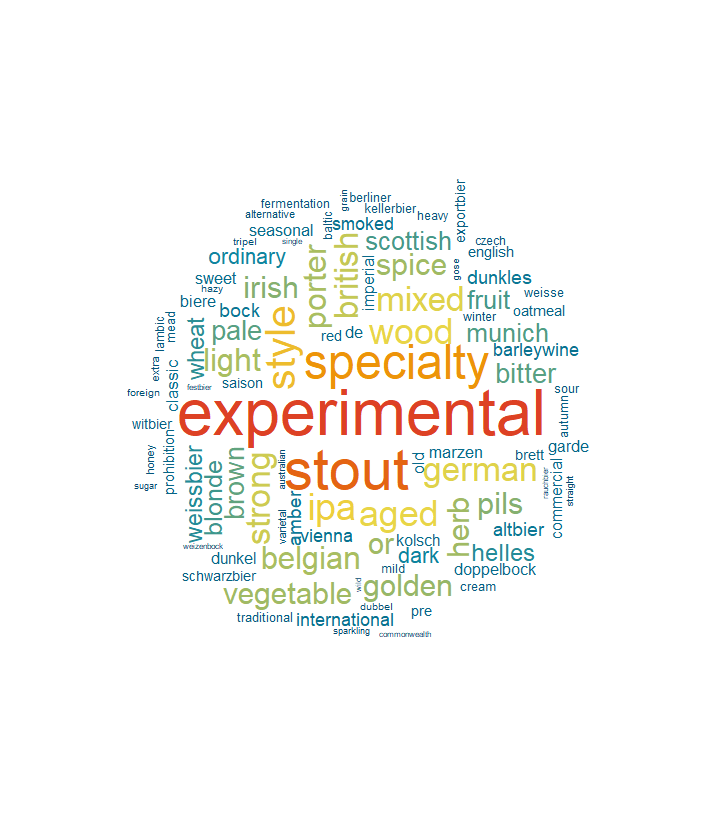Craft Beer
I love quality craft beer!
Introduction: Why Did I Do This?
This document is best viewed in the light theme mode. If this document has a dark background, I suggest you toggle the theme by clicking on the toggle button on the top right of this page. (It’s the icon to the left of thes earch icon.)
Why? Easy to answer - I love craft beer and I have before many of you enjoyed your first beer. Decades ago I can say that I traveled to every craft brewery in the US - at least everyone that I could find! It was fun to try the beers (typically over-indulging by trying a pint of each one). I would enjoy some good food - most of the time. Like many, I collected pint glasses and did so for many years. Once I ran out of wall space, the nearly 1,000 pint glasses were given away. I did save a few that held particular memories.
I have been a beer judge, brewed many barrels of beer at home and as a guest brewer, and I have traveled to the Great American Beer Festival (GABF) many times. I maintain 3 kegs in my home all the time. (I do not share beer with my Golden Retriever, Wheat.)

Professionally, my life has involved data, most recently as a data scientist. As such, I love data and order. When I studied to become a certified beer judge (Beer Judge Certification Program, Inc. (BJCP), I loved learning the history, definitions and categorization of many beer styles. Foolishly, I thought everyone would follow these beer style and categorization recommendations. Like so many times in my life, I was wrong. When I reviewed results of the 2022 GABF results, I saw styles of beer categorized in ways I did not recognize. At the time, I thought nothing of it. I assumed that my memory had began to fade and my recall was mistaken. But then I started to look a bit deeper and found even at GABF beer naming recommendations were often ignored.
This set in motion a project I thought would take days that turned into months. Reconciling the entire history GABF results became an obsession. I then harmonized not only GABF recommendations but also beer categorization recommendations from the Brewers Association and Beer Advocate.
After normalizing the data, I explore GABF results using BJCP 2021 guidelines. This calibrates the data so comparisons are more consistent and accurate. You can find lots of data analysis on beer competitions on the web, but I believe this work is original and unparalleled. I could find no other resources that have taken 40 years of GABF competitions and categorized everything per BJCP 2021 guidelines. This leads to better and more consistent analytical results when comparing beer preferences over time.
Enjoy!
Beer 101
Fermenting grains used to create beer, it was a process that was done in the home (or cave). This begs the question - when did mankind start brewing? Well, we don’t really know. Historians currently believe that the first fermented beverages were around 12,000 years ago - close to when humans began developing crops. But we have hard evidence of brewing about 6,000 years ago in the form of a Sumerian tablet and a 3,900 year old poem that contains the oldest known recipe.
A few millenia later. . . .Prohibition
The U.S. flirted with the idea of being dry but it just drove brewing back into the home. In 1919 it became illegal to make, buy, or sell intoxicating beverages. However, had it not been for Prohibition we might not have malt syrups and there may not be wide scale extract brewing. Since the large breweries could not make beer, they simply started turning out these malt extracts and selling them for baking. The American home brewer was excited to do some baking. In 1926, 438 million pounds of malt extract were produced and the next year it was up to 450 million. In a single year during Prohibition, hop sales for this home baking exceeded 13 million pounds. By 1929, the Prohibition Bureau estimated that approximately 700 million gallons of beer was made at home. Then in 1933 a funny thing happened. Prohibition was done away with, the 160 breweries (down from 2,300 in 1880 and 1,400 in 1914) in the country could once again start churning out beer.
Due to an oversight in the way the law was written, while making wine at home was legal, brewing a batch of beer at home remained forbidden. This didn’t stop people completely, of course. As more and more groups of people broke the law to brew at home the US government got around to correcting its oversight - 45 years later. Jimmy Carter signed HR 1337 into law which made it explicitly legal to homebrew beer. When that law was passed, there were only ~50 breweries in the USA. Today, there are ~7k permitted breweries. With that in mind, when the GABF festival started, breweries like Anheuser-Busch, Miller Brewing Company, and Coors Brewing Company controlled even more of the market share than they do today. The newcomers at that time were Boston Beer Company (i.e. Sam Adams) and Alaskan Brewing Co., founded in 1984 and 1986 respectively. That history plays a significant role in our analysis because the newer breweries of today are years behind these older breweries with regard to winning awards. (You will learn more about this when Pabst is explored later in this document.)
The 1978 law only applied at the federal level. The states were allowed to make their own laws regarding homebrewing. Since 1978, the beer industry has boomed. To support the home brewer more maltsters, hop growers, yeast labs and shops have popped up across the country. The home brewing movement has provided the growing craft brew industry with many of its brewers and customers. Finally in 2013 Alabama and Mississippi have voted to legalize home brewing, meaning that for the first time since 1919 it was legal to brew in your home in every State of the country.

To equitably compare beer competitions, you must first know about 2 key organizations:
- Great American Beer Fest (GABF)
- Beer Judge Certification Program (BJCP)
GABF - What is it?

Established in 1982, GABF is the largest ticketed beer festival in the U.S. and one of the largest in the world. GABF was founded by brewer Charlie Papazian. The first festival was held in conjunction with the American Homebrewers Association’s annual conference in Boulder, Colorado in June 1982, featuring 24 participating breweries and 47 beers. In a private event held the week prior, judges evaluated the beers in the associated competition, and awarded medals in over 100 beer style categories. In 2019, the panel consisted of 322 judges from 18 countries, who evaluated over 9,400 beers from 800 breweries. The in-person festival was cancelled in 2020 and 2021, with a virtual event held instead, due to the COVID-19 pandemic. It returned in 2022.
The GABF is held every year in Denver, Colorado. A wide diversity of American beers side by side with leading beers from all over the world is offered in the festival. Dozens of beer masters and beers judges from the US and abroad test the quality of the beers according to categories and grade it. The three leading beers will get medals: gold, silver, and bronze.
What is the Beer Judge Certification Program?
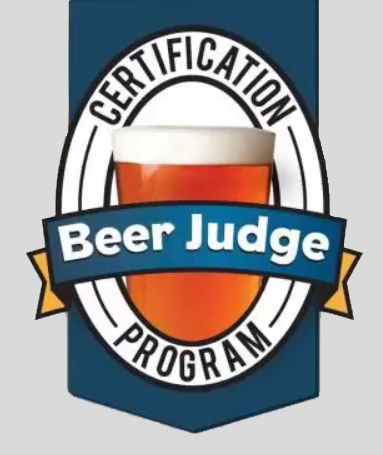
The Beer Judge Certification Program, Inc. (BJCP) is a world-wide certifying organization for judges of beer and related fermented products. Founded in 1985, it has a presence in over 60 countries and have more than 7500 active judges in the program. Judges are certified through an examination covering technical aspects of brewing, world beer styles, the purpose of the BJCP, and judging procedures, and by demonstrating practical judging skills. Judges are ranked based on their examination scores and accumulation of practical judging experience.
Most pertinent to this analysis is the BJCP guidelines. These guidelines are just that - guidelines, not commandments. Competitions may create their own award categories that are distinct from the style categories in these guidelines. There is no requirement that competitions use style categories as award categories! Individual styles can be grouped in any manner to create desired award categories in competition; for instance, to evenly distribute the number of entries in each award category.
BJCP realizes that many of the defined styles can have alternate names, or are called different things in other (or even the same) parts of the world. In the past, BJCP used multiple names in style titles to avoid showing preference, but this too often led people to incorrectly use all those names simultaneously. So, BJCP selected one unambiguous name for each style.
The BJCP Style Guidelines use some specific terms with specialized meaning: Category, Subcategory and Style. When thinking of beer, mead and cider styles, the subcategory is the most important label - subcategory means essentially the same thing as style and identifies the major characteristic of one type of beer, mead or cider. The larger categories are arbitrary groupings of beers, meads or ciders, usually with similar character but some subcategories are not necessarily related to others within the same category. The purpose of the structure within the BJCP Style Guidelines is to group styles of beer, mead and cider for competition purposes; do not attempt to derive additional meaning from these groupings.
Guidelines are meant to describe general characteristics of the most common examples, and serve as an aid for judging; they are not meant to be rigorously-applied specifications that are used to punish slightly unusual examples. They are suggestions, not hard limits. Allow for some flexibility in judging so that well-crafted examples can be rewarded. The guidelines are written in detail to facilitate the process of the structured evaluation of beer as practiced in home brewing competitions; don’t use each individual statement in style descriptions as a reason to disqualify a beer.
BJCP tenets are:
- BJCP Style Guidelines are guidelines not specifications.
- Style Guidelines are written primarily for homebrew competitions - style descriptions are written primarily to aid in judging.
- Styles change over time
- Not every commercial beer fits BJCP styles
- BJCP has not defined every possible beer style
- Commercial examples change over time
- Ingredients change over time
- Most styles are fairly broad
- BJCP Guidelines are extensible
Style History
In 2015, many styles were added, some styles were divided into multiple categories, and some simply renamed. Styles are organized into categories following a philosophy that groups styles with similar judging characteristics rather than a common heritage or family name. Do not assume that the same primary characteristic (e.g., color, strength, balance, dominant flavor, country of origin) was used to determine each category grouping - the reasoning was more nuanced.
The 2021 BJCP Style Guidelines are a minor revision to the 2015 edition, itself a major update of the 2008 edition. The goals of the 2015 edition were to better address world beer styles as found in their local markets, keep pace with emerging craft beer market trends, describe historical beers now finding a following, better describe the sensory characteristics of modern brewing ingredients, take advantage of new research and references, and help competition organizers better manage the complexity of their events. These goals have not changed in the 2021 edition.
Beer Styles - A Problem
Under the current 2021 Guidelines, GABF recommends 33 Categories of beer.
[1] "Standard American Beer" "International Lager"
[3] "Czech Lager" "Pale Malty European Lager"
[5] "Pale Bitter European Beer" "Amber Malty European Lager"
[7] "Amber Bitter European Beer" "Dark European Lager"
[9] "Strong European Beer" "German Wheat Beer"
[11] "British Bitter" "Pale Commonwealth Beer"
[13] "Brown British Beer" "Scottish Ale"
[15] "Irish Beer" "Dark British Beer"
[17] "Strong British Ale" "Pale American Ale"
[19] "Amber and Brown American Beer" "American Porter and Stout"
[21] "IPA" "Strong American Ale"
[23] "European Sour Ale" "Belgian Ale"
[25] "Strong Belgian Ale" "Historical Beer"
[27] "American Wild Ale" "Fruit Beer"
[29] "Spiced Beer" "Alternative Fermentables Beer"
[31] "Smoked Beer" "Wood Beer"
[33] "Specialty Beer" These categories are the divided into recommended styles of beer:
[1] "American Light Lager" "American Lager"
[3] "Cream Ale" "American Wheat Beer"
[5] "International Pale Lager" "International Amber Lager"
[7] "International Dark Lager" "Czech Lager"
[9] "Czech Premium Pale Lager" "Czech Amber Lager"
[11] "Czech Dark Lager" "Munich Helles"
[13] "Festbier" "Helles Bock"
[15] "German Leichtbier" "Kolsch"
[17] "German Helles Exportbier" "German Pils"
[19] "Marzen" "Rauchbier"
[21] "Dunkles Bock" "Vienna Lager"
[23] "Altbier" "Munich Dunkel"
[25] "Schwarzbier" "Doppelbock"
[27] "Eisbock" "Baltic Porter"
[29] "Weissbier" "Dunkles Weissbier"
[31] "Weizenbock" "Ordinary Bitter"
[33] "Best Bitter" "Strong Bitter"
[35] "British Golden Ale" "Australian Sparkling Ale"
[37] "English IPA" "Dark Mild"
[39] "British Brown Ale" "English Porter"
[41] "Scottish Light" "Scottish Heavy"
[43] "Scottish Export" "Irish Red Ale"
[45] "Irish Stout" "Irish Extra Stout"
[47] "Sweet Stout" "Oatmeal Stout"
[49] "Tropical Stout" "Foreign Extra Stout"
[51] "British Strong Ale" "Old Ale"
[53] "Wee Heavy" "English Barleywine"
[55] "Blonde Ale" "American Pale Ale"
[57] "American Amber Ale" "California Common"
[59] "American Brown Ale" "American Porter"
[61] "American Stout" "Imperial Stout"
[63] "American IPA" "Specialty IPA"
[65] "Hazy IPA" "Double IPA"
[67] "Strong American Ale" "American Barleywine"
[69] "Wheatwine" "Berliner Weisse"
[71] "Flanders Red Ale" "Oud Bruin"
[73] "Lambic" "Gueuze"
[75] "Fruit Lambic" "Gose"
[77] "Witbier" "Belgian Pale Ale"
[79] "Biere de Garde" "Belgian Blonde Ale"
[81] "Saison" "Belgian Golden Strong Ale"
[83] "Monastic Ale" "Belgian Single"
[85] "Belgian Dubbel" "Belgian Tripel"
[87] "Belgian Dark Strong Ale" "Kellerbier"
[89] "Kentucky Common" "Lichtenhainer"
[91] "London Brown Ale" "Piwo Grodziskie"
[93] "Pre-Prohibition Lager" "Pre-Prohibition Porter"
[95] "Roggenbier" "Sahti"
[97] "Brett Beer" "Mixed-Fermentation Sour Beer"
[99] "Wild Specialty Beer" "Straight Sour Beer"
[101] "Fruit Beer" "Fruit and Spice Beer"
[103] "Specialty Fruit Beer" "Grape Ale"
[105] "Spice, Herb, or Vegetable Beer" "Autumn Seasonal Beer"
[107] "Winter Seasonal Beer" "Specialty Spice Beer"
[109] "Alternative Grain Beer" "Alternative Sugar Beer"
[111] "Classic Style Smoked Beer" "Specialty Smoked Beer"
[113] "Wood-Aged Beer" "Specialty Wood-Aged Beer"
[115] "Commercial Specialty Beer" "Mixed-Style Beer"
[117] "Experimental Beer" Given these standards, you would think they would be followed by the judges in competitions. Not the case! Like all data, the data from GABF Competitions is dirty and problematic. Reviewing all the competitions to date, 538 distinct styles are used. Here is a sample:
[1] "American Amber Lager"
[2] "American Amber/Red Ale"
[3] "American Black Ale or American Stout"
[4] "American Cream Ale"
[5] "American Fruit Beer"
[6] "American Pilsener"
[7] "American Sour Ale"
[8] "American Wheat Beer"
[9] "American-Belgo-Style Ale"
[10] "American-Style Brown Ale"
[11] "American-Style India Pale AleCategory Sponsor: Micro Matic"
[12] "American-Style Lager"
[13] "American-Style Pale AleCategory Sponsor: Grandstand"
[14] "American-Style Strong Pale Ale"
[15] "Australasian, Latin American or Tropical Light Lager"
[16] "Belgian Fruit Beer"
[17] "Belgian-Style Abbey Ale"
[18] "Belgian-Style Ale or French-Style Ale"
[19] "Belgian-Style Sour Ale"
[20] "Belgian-Style Strong Specialty Ale"
[21] "Belgian-Style Witbier"
[22] "Bock"
[23] "Bohemian-Style PilsenerCategory Sponsor: Wyeast Laboratories"
[24] "Brett BeerCategory Sponsor: Wyeast Laboratories"
[25] "Brown Porter"
[26] "Chili Beer"
[27] "Chocolate Beer"
[28] "Classic Saison"
[29] "Coffee Beer"
[30] "Coffee Stout or PorterCategory Sponsor: Chart Industries" The Beer Categorization and Style Problem
The primary problem with GABF Competition results are that only a Category is recorded. There is no distinction between a Category or a Style of beer (or Sub-Style). Therefore, the information provided requires interpretation to derive the appropriate Category and Style. This effort is not perfect. Assumptions had to be made. The competition results provided limited information on the type of beer judged. There is no distinction between Category or Style. For example, an entry of American Black Ale or American Stout was modified with a Category of American Porter and Stout and a style of American Stout. There is no way to go back in time to determine if the beer in question (in this case it was called
Hooked On Onyx) was truly a stout or not. I had to guess.
Want to peek inside some of the code that does all this work? Not really, huh? Some might want to see.
Category_Raw == "Chili Beer" ~ "Spiced Beer",
Category_Raw == "Chocolate Beer" ~ "Spiced Beer",
Category_Raw == "Classic Saison" ~ "Strong Belgian Ale",
Category_Raw == "Coffee Beer" ~ "Spiced Beer",
Category_Raw == "Contemporary American-Style Lager" ~ "Standard American Beer",
Category_Raw == "Contemporary Gose" ~ "European Sour Ale",
Category_Raw == "Dortmunder or German-Style Oktoberfest" ~ "Pale Bitter European Beer",
Category_Raw == "English Ale" ~ "British Bitter",
Category_Raw == "English India Pale Ale or New Zealand India Pale Ale" ~ "Pale Commonwealth Beer",
Category_Raw == "Experimental India Pale Ale" ~ "Specialty Beer",
Category_Raw == "Experimental Wood-Aged Beer" ~ "Wood Beer",
Category_Raw == "Extra Special Bitter" ~ "British Bitter",
Category_Raw == "Field Beer" ~ "Spiced Beer",
Category_Raw == "Fresh Hop Beer" ~ "Specialty Beer",
Category_Raw == "Fruit Wheat Beer" ~ "Fruit Beer",
Category_Raw == "Fruited American Sour Ale" ~ "American Wild Ale",
Category_Raw == "German Dark Lager" ~ "Dark European Lager",
Category_Raw == "German-Style Dark Lager" ~ "Dark European Lager",
Category_Raw == "German Sour Ale" ~ "European Sour Ale",
Category_Raw == "German Wheat Ale" ~ "German Wheat Beer",This was an exhausting effort (1,00s of category and style transformations), but all the previous GABF Competition results have been normalized to the current beer categories and beer styles defined in the 2021 GABF Standards.
In the end, I assert this review of beer is more accurate than any before it. Assigning standards to the beer categories and styles make the analysis and results more accurate, trustworthy and repeatable.
| Compare Festival Categorization to GABF 2021 Recommedations | ||
| GABF Results | Category Count | Style Count |
|---|---|---|
| Raw | 520 | Not Available |
| Modified to Fit Standards | 33 | 117 |
Alternative Beer Categorization
While BJCP Guidelines are undoubtedly the leading source for beer categorizing and style descriptions, it is not the only source. BJCP Guidelines are useful for professional brewers and craft brewing enthusiasts. For the ones more interested in drinking the beer than knowing the beer, broader definitions/guidelines are available. Beer Advocate and Brewers Association are two examples.
Both organizations greatly simply the identification of beer styles. BJCP supports 34 categories of beer compared to 10 and 16 categories from the Brewers Associations and Beer Advocate, respectfully.
| Amber and Brown American Beer | North American Origin Lager Styles | Pale Lagers |
| American Porter and Stout | North American Origin Ale Styles | Pale Ales |
| Standard American Beer | All Origin Hybrid Mixed Lagers or Ales | Stouts |
| Fruit Beer | Belgian and French Origin Ale Styles | Hybrid Beers |
| Historical Beer | British Origin Ale Styles | Specialty Beers |
| American Wild Ale | European Origin Lager Styles | Wild-Sour Beers |
| Specialty Beer | German Origin Ale Styles | Wheat Beers |
| Belgian Ale | Mead | Brown Beers |
| Strong Belgian Ale | Irish Origin Ale Styles | India Pale Ales |
| IPA | Other Origin Lager Styles | Strong Ales |
| Strong American Ale | Bocks | |
| European Sour Ale | Porters | |
| Amber Malty European Lager | Dark Ales | |
| Pale Bitter European Beer | Brown Ales | |
| Spiced Beer | Dark Lagers | |
| British Bitter | Mead | |
| Pale Commonwealth Beer | ||
| Brown British Beer | ||
| Wood Beer | ||
| Dark European Lager | ||
| German Wheat Beer | ||
| Amber Bitter European Beer | ||
| Strong European Beer | ||
| Pale American Ale | ||
| Mead | ||
| International Lager | ||
| Irish Beer | ||
| Pale Malty European Lager | ||
| Dark British Beer | ||
| Strong British Ale | ||
| Scottish Ale | ||
| Smoked Beer | ||
| Czech Lager | ||
| Alternative Fermentables Beer | ||
| 34 | 10 | 16 |
Beer Tree Maps
To understand how different the different guidelines are, tree maps are useful to show this information graphically in a manneer that is easily interpreted. To get started on this path to understanding, let’s evaluate the raw GABF results in terms of the beer styles represented in the last 40 years.
In the image below, it is clear there have been many styles of beer (remember, most of these were not named using BJCP guidelines so it it a bit misleading). The larger the rectangle, the more entries for that specific style have been recorded. Bock, Robust Porter, Imperial Stout and others have been entered many times compared to may other styles of beer.
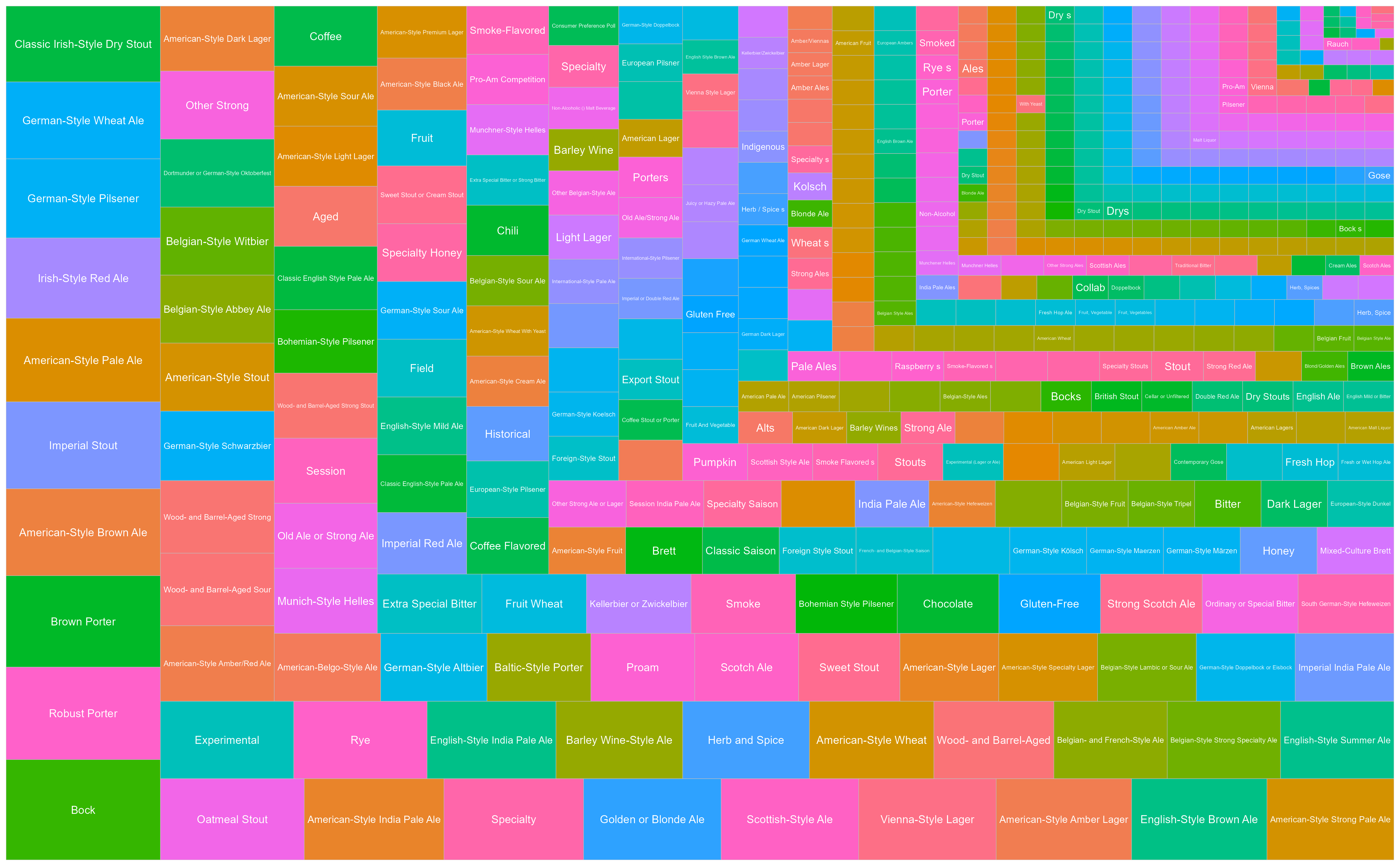
Now compare the beer categories of the 3 organizations. The simplicity of the Beer Advocate and Brewers Associations recommendations is simple compared to the more comprehensive BJCP 2021 Guideline Recommendations.
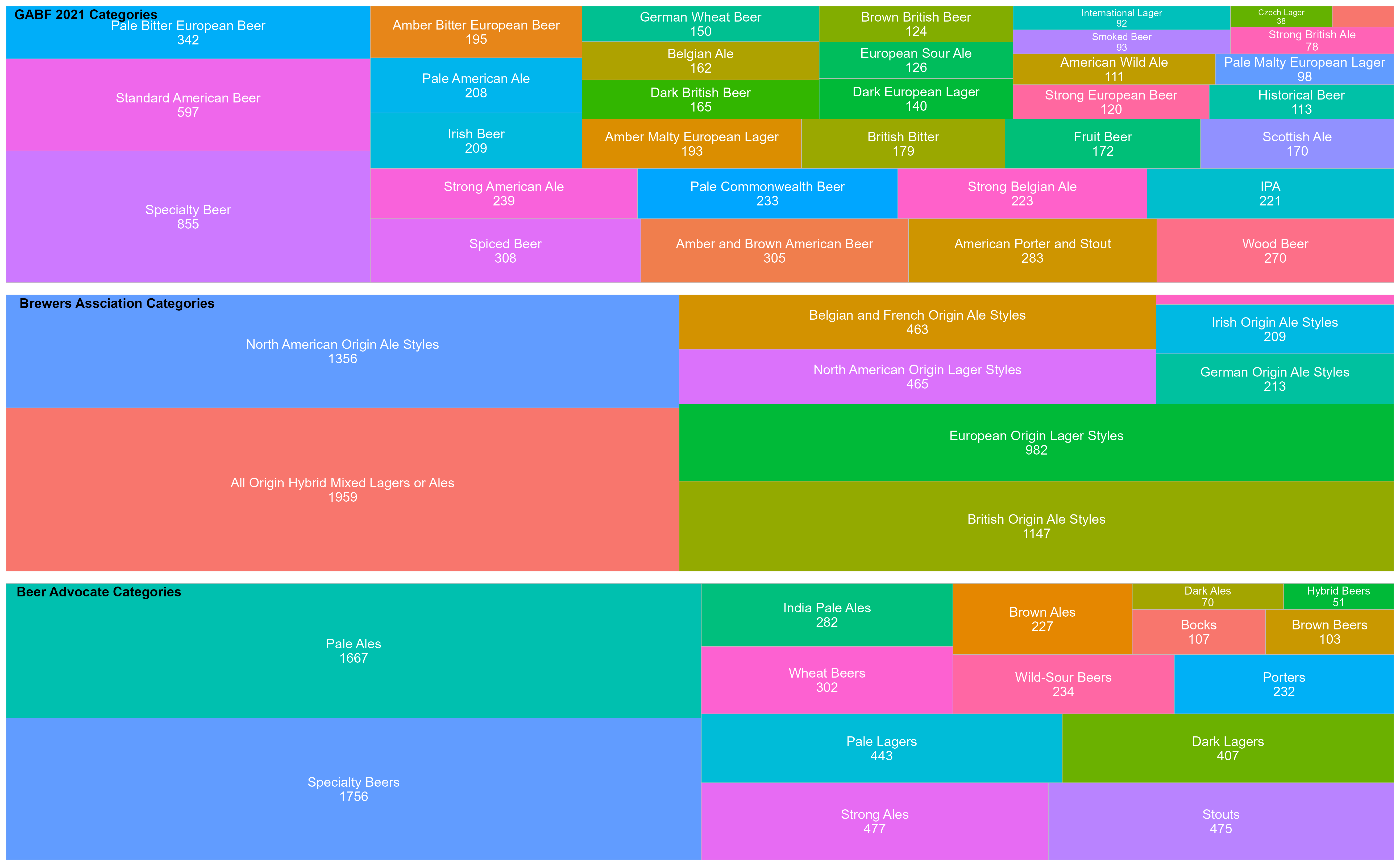
Beer Competitions
Now that we understand beer and GABF Competitions, let’s start seeing some competition results!
First, let’s see who entered and was awards GABF Medals in the first few years of the competition.
| Great American Beer Festival | |||||||
| The early years. There was only one category of beer - Consumer Preference Poll. |
|||||||
| Beer Name | Brewery | City | State | Category | Medals Won | ||
|---|---|---|---|---|---|---|---|
| 🥇 | 🥈 | 🥉 | |||||
| 1983 | |||||||
| Sierra Nevada Pale Ale | Sierra Nevada Brewing | Chico | CA | Consumer Preference Poll | 1 | 0 | 0 |
| Sierra Nevada Porter | Sierra Nevada Brewing | Chico | CA | Consumer Preference Poll | 0 | 1 | 0 |
| Anchor Porter | Anchor Brewing | San Francisco | CA | Consumer Preference Poll | 0 | 0 | 1 |
| 1984 | |||||||
| Russian Imperial Stout | Yakima Brewing | Sunnyside | WA | Consumer Preference Poll | 1 | 0 | 0 |
| Grants Scottish Ale | Yakima Brewing | Sunnyside | WA | Consumer Preference Poll | 0 | 1 | 0 |
| New Amsterdam Amber | Old New York Brewing | New York | NY | Consumer Preference Poll | 0 | 0 | 1 |
| 1985 | |||||||
| Samuel Adams Boston Lager | Boston Beer | Boston | MA | Consumer Preference Poll | 1 | 0 | 0 |
| Hibernia Dunkel Weizen | Hibernia Brewing | Eau Claire | WI | Consumer Preference Poll | 0 | 1 | 0 |
| Snake River Amber Lager | Snake River Brewing | Jackson | WY | Consumer Preference Poll | 0 | 0 | 1 |
| 1986 | |||||||
| Samuel Adams Boston Lager | Boston Beer | Boston | MA | Consumer Preference Poll | 1 | 0 | 0 |
| Festival Ale | Boulder Brewing | Boulder | CO | Consumer Preference Poll | 0 | 1 | 0 |
| Dock Street Amber Ale | Dock Street Brewing | Philadelphia | PA | Consumer Preference Poll | 0 | 0 | 1 |
| 1987 | |||||||
| Samuel Adams Festival Lager | Boston Beer | Boston | MA | Consumer Preference Poll | 1 | 0 | 0 |
| Chinook Alaskan Amber Beer | Alaskan Brewing and Bottling | Juneau | AK | Consumer Preference Poll | 0 | 0 | 1 |
| 1988 | |||||||
| Chinook Alaskan Amber | Alaskan Brewing and Bottling | Juneau | AK | Consumer Preference Poll | 1 | 0 | 0 |
| 1989 | |||||||
| Samuel Adams Boston Lager | Boston Beer | Boston | MA | Consumer Preference Poll | 1 | 0 | 0 |
Complete GABF Competition Results
The entire history of GABF Results is presented below into 2 tables. The first table format is one I prefer but the overhead of the medal icons creates a technical challenge that I had to avoid by capturing the last 5 years of results in the first table.
All GABF Awards Winners of the Past 5 Years
The table below contains all the data older than2017. The medal icons were replaced with a color-coded tile.
Older GABF Awards Winners
Other Winners
I do not know the reasoning for providing special attention to a few breweries, but since they are part of the GABF records, they are included below to ensure I provide all the data. (Afterall don’t most breweries deliver well-crafted brews?)
I am pleased Stoudts was recognized in 1991. It was a brewery I visited many times. Founded in 1987, long before craft beer was a term or even a known thing, Stoudts Brewing Company produced authentic German-style ales and lagers, distributing to 20 different states at its height. Carol Stoudt, the founder of the brand, has been a long-standing pioneer in the brewing industry. She became the first female head brewer since prohibition and has served as an inspiration both for women in the industry and anyone passionate about great beer.
Unfortunately, Stoudts Brewing Company, one of Pennsylvania’s first craft breweries, closed its doors after more than a 30-year run in 2020. Happily, just two years later, the Stoudts is back, having partnered with Evil Genius Beer Company. Evil Genius will reproduce some of Stoudts best beers!
| Other GABF Special Recognition Winners | ||||
| BeerName | Brewery | City | State | Category |
|---|---|---|---|---|
| Small Brewing Company and Small Brewing Company Brewer of the Year - 1999 | ||||
| Boiler Room Dark Lager | Colorado Belle | Laughlin | NV | American Dark Lager |
| Honorable Mention - 1999 | ||||
| Michelob Amber Bock | Specialty Brewing Group of Anheuser-Busch | Saint Louis | MO | American Dark Lager |
| Small Brewpub and Small Brewpub Brewer of the Year - 1999 | ||||
| BrewÛ 22 | Mill Creek Brewpub | Walla Walla | WA | American Lager / Ale or Cream Ale |
| Honorable Mention - 1995 | ||||
| Naughty Monkey Brown Ale | Seabright Brewery | Santa Cruz | CA | American Brown Ale |
| Stoudt's Honey Double Mai-Bock | Stoudt's Brewing | Adamstown | PA | Bock |
| Pullman Pale Ale | Riverside Brewing | Riverside | CA | Classic English Style Pale Ale |
| Red Mountain Red Ale | Vulcan Brewing | Birmingham | AL | English-Style Brown Ale |
| Pullman's Porter | McNeill's Brewery | Brattleboro | VT | Robust Porter |
| Kinnikinick Old Scout Stout | Twenty Tank Brewery | San Francisco | CA | Specialty Stouts |
| Net Gamelink Hubscotch Ale | Schooner Brewery | Dallas | TX | Strong Ale |
| Bourbon County Stout | Goose Island Beer | Chicago | IL | Strong Ale |
| Honorable Mention - 1994 | ||||
| Hubsch Pilsner | Sudwerk Privatbrauerei Hubsch | Davis | CA | European Pilsner |
| Juju Ginger Ale | Left Hand/Tabernash Brewing | Longmont | CO | Herb, Spice |
| Honorable Mention - 1991 | ||||
| Killer Whale Stout | Stoudt's Brewing | Adamstown | PA | Stouts |
| The Category column has not been modified to reflect 2021 standards for beer catergory or style. | ||||
Beer Categories Expand
The number of unique styles entered into GABF competitions has grown significantly. But, does this make sense? Sure it does. Beer has been around thousands of years but ingredients, brewing methods and cultural changes all impact beer tastes. After all, enjoying beer is a social event!
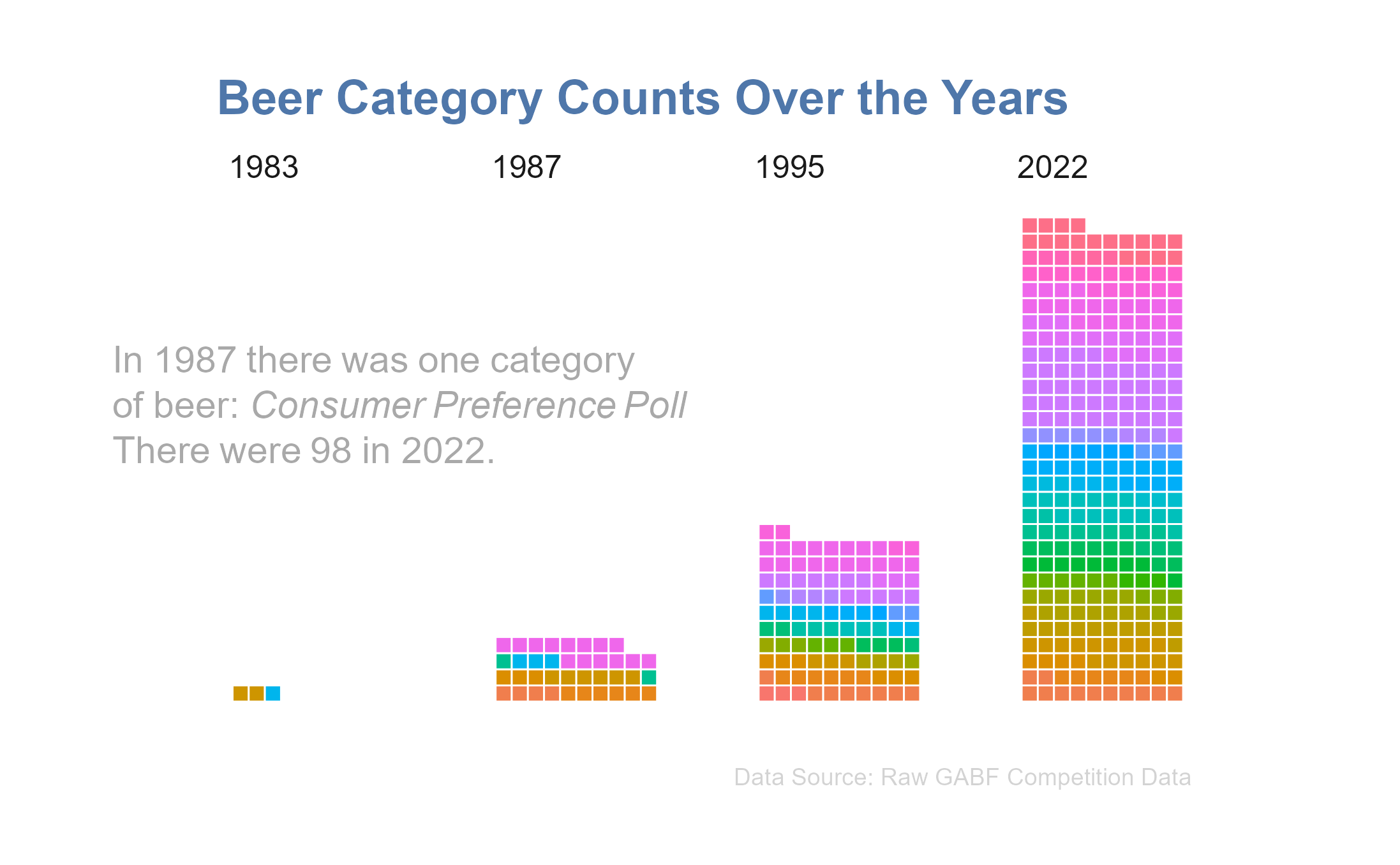
Recent Interest in Varietal Beer Styles
Over the years as the number of beer styles increased, Specialty Beers and IPAs became more prevalent.
Specialty Beer: This is explicitly a catch-all category for any beer that does not fit into an existing style category. No beer is ever out of style in this category, unless it fits elsewhere. The category is intended for any type of beer. This category can also be used as an incubator for any minor world beer style (other than Belgians) for which there is currently no BJCP category. If sufficient interest exists, some of these minor styles might be promoted to full styles in the future.
IPA: The IPA category is for modern American IPAs and their derivatives. This does not imply that English IPAs aren’t proper IPAs or that there isn’t a relationship between them. This is simply a method of grouping similar styles for competition purposes. English IPAs are grouped with other English-derived beers, and the stronger Double IPA is grouped with stronger American beers. The term IPA is intentionally not spelled out as India Pale Ale since none of these beers historically went to India, and many aren’t pale. However, the term IPA has come to be a balance-defined style in modern craft beer.
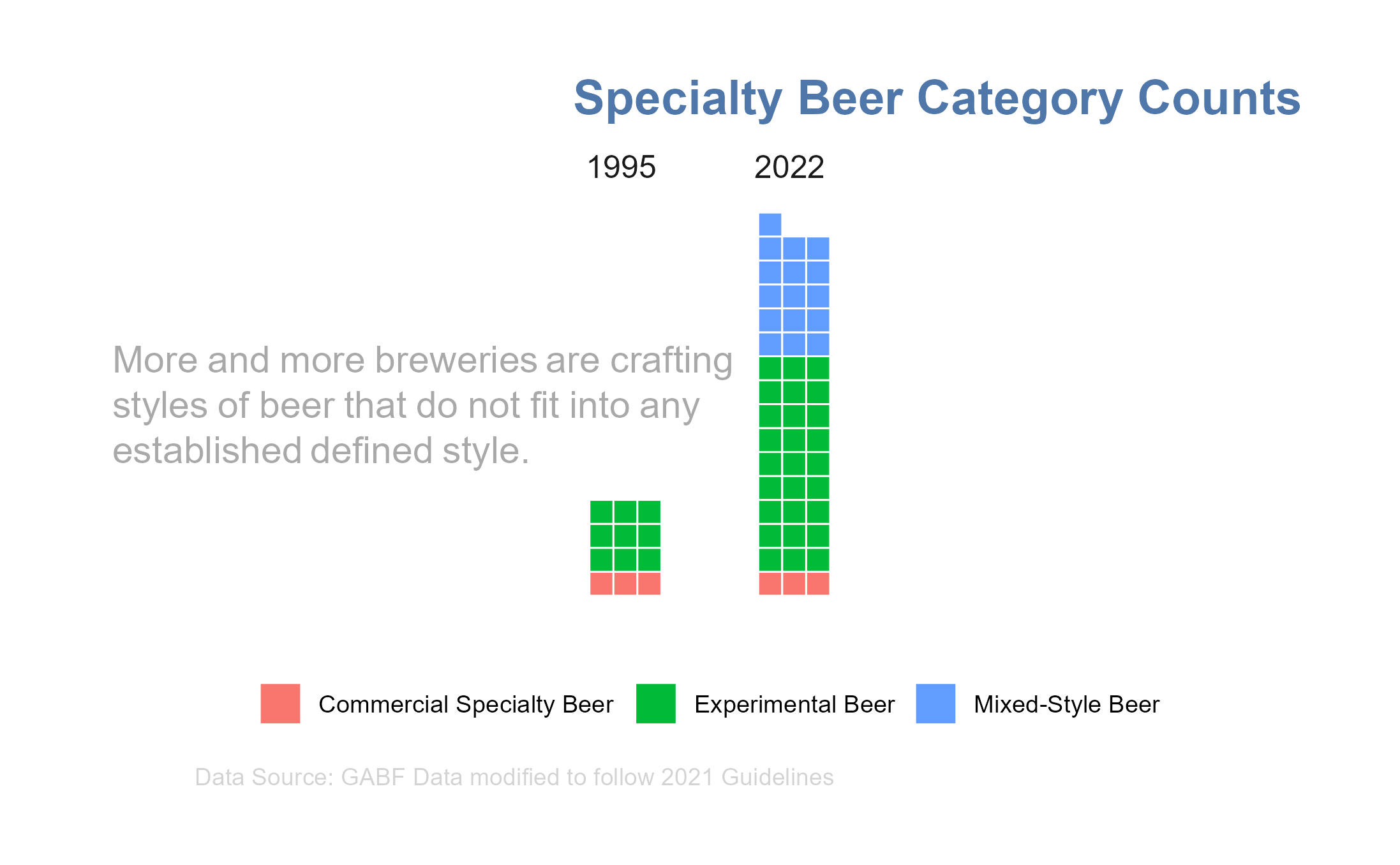

Medal Counts
Medal Counts by Brewery
Let’s discover which breweries have been awarded the most medals over the years. There are a few surprises - at least I think so!
The GABF is older than most of the breweries that participated in 2022. The competition in 2022 was completely different, more crowded, than it was in the beginning. When looking at total awards, this is not accounted for.
2022 Medals
Before seeing which breweries have been awarded the most medals in 2022, here is the first surprise from the 2022 competition.
West Virginia recieved its first GABF Medal in 2022!
| West Virginia Wins 1st GABF Award! | |||||
| Medal | Beer Name | Brewery | City | Category | Style |
|---|---|---|---|---|---|
| Silver | Porter | Big Timber Brewing | Elkins | American Porter and Stout | American Porter |
Congratulations Big Timber Brewing! While I have been to Elkins, WV several times, it was before Big Timber opened. I look forward to stoppong by in the future.
Below are the rest of the results from the 2022 GABF Competition
| Great American Beer Festival 2022 | ||||
| Breweries winning multiple medals. (2 in NC!) 238 of 294 breweries were awarded exactly 1 medal. |
||||
| Medals Won | ||||
|---|---|---|---|---|
| 🥇 | 🥈 | 🥉 | Total | |
| North Park Beer | 1 | 1 | 2 | 4 |
| Ghost Town Brewing | 2 | 1 | 0 | 3 |
| Wild Fields Brewhouse | 3 | 0 | 0 | 3 |
| 10 Barrel Brewing Co Bend Pub | 1 | 0 | 1 | 2 |
| Bearded Tang Brewing | 0 | 2 | 0 | 2 |
| Blind Tiger Brewery Restaurant | 2 | 0 | 0 | 2 |
| Chicago Brewing Co NV | 1 | 0 | 1 | 2 |
| Deschutes Brewery Portland Brewery Public House | 1 | 1 | 0 | 2 |
| Double Clutch Brewing | 0 | 2 | 0 | 2 |
| Faction Brewing | 1 | 0 | 1 | 2 |
| Forgotten Star Brewing | 1 | 1 | 0 | 2 |
| Highland Park Brewery Chinatown | 1 | 0 | 1 | 2 |
| Left Hand Brewing | 0 | 1 | 1 | 2 |
| Morgan Territory Brewing | 0 | 0 | 2 | 2 |
| Odd Breed Wild Ales | 0 | 0 | 2 | 2 |
| Olde Hickory Brewery | 0 | 0 | 2 | 2 |
| Our Mutual Friend Brewing | 1 | 1 | 0 | 2 |
| Pecan Street Brewing | 1 | 0 | 1 | 2 |
| Precarious Beer Project Precarious Beer Hall | 1 | 1 | 0 | 2 |
| Protagonist Beer Southend Brewery | 1 | 1 | 0 | 2 |
| Red Rock Brewing Production | 0 | 1 | 1 | 2 |
| Riip Beer | 0 | 1 | 1 | 2 |
| The Austin Beer Garden Brewing | 1 | 1 | 0 | 2 |
| The Big Friendly | 1 | 1 | 0 | 2 |
| Third Window Brewing | 1 | 0 | 1 | 2 |
| Topa Topa Brewing Co HQ | 1 | 1 | 0 | 2 |
Here is another surprise. North Park Beer won 4 medals in 2022! I did not think a brewery ever won more than 3 medals in any given year at the GABF Competition.
| Great American Beer Festival 2022 | ||||
| North Park Beer Company | ||||
| Medals Won | ||||
|---|---|---|---|---|
| 🥇 | 🥈 | 🥉 | ||
| DoubleFu | Mixed-Style Beer | 1 | ||
| HopFu | American IPA | 1 | ||
| NZFu | English IPA | 1 | ||
| XRaying Citra | Mixed-Style Beer | 1 | ||

Mega Winning Breweries
Has any other brewery won 4 or more medals in 1 year? The answer is YES - another surprise! It has happened 97 times! There are 9 instances where breweries have won more than 6 medals. Incredible!
| MEGA Award Winning Breweries | ||
| Year | Brewery | Grand Total |
|---|---|---|
| 2006 | Miller Brewing | 9 |
| 2004 | Pabst Brewing | 9 |
| 2011 | Sun King Brewing | 8 |
| 2008 | MillerCoors | 8 |
| 2010 | Rock Bottom Breweries | 7 |
| 2010 | Pizza Port Carlsbad | 7 |
| 2009 | Pizza Port Carlsbad | 7 |
| 2007 | Miller Brewing | 7 |
| 2005 | Sandlot Brewery at Coors Field | 7 |
Way to go Pizza Port Carlsbad! I have been there a few times and the beer, food, and people are terrific. I have also visited many Rock Bottom Breweries. I started first enjoying their beer when I lived in Arizona. They offer surprisingly good beer given it is a chain brewery. One has opened near me. I have yet to try it - but I will!
Here are the details of these MEGA-Winning breweries.
| Great American Beer Festival MEGA Winners | |||||
| Breweries winning MANY medals. | |||||
| Medals Won | |||||
|---|---|---|---|---|---|
| 🥇 | 🥈 | 🥉 | |||
| 2006 - Miller Brewing | |||||
| Red Dog | Cream Ale | 1 | |||
| Henry Weinhard Private Reserve | Cream Ale | 1 | |||
| Miller High Life | American Lager | 1 | |||
| Milwaukees Best Light | American Light Lager | 1 | |||
| Southpaw Light | American Light Lager | 1 | |||
| Mickeys Malt Liquor | Mixed-Style Beer | 1 | |||
| Icehouse | Mixed-Style Beer | 1 | |||
| HG 800 | Mixed-Style Beer | 1 | |||
| Fred Millers Classic Chocolate Lager | Spice, Herb, or Vegetable Beer | 1 | |||
| Total | — | — | 2 | 3 | 4 |
| 2004 - Pabst Brewing | |||||
| Special Export | American Lager | 1 | |||
| Old Milwaukee | American Lager | 1 | |||
| Schlitz | American Lager | 1 | |||
| Rainier Light | American Light Lager | 1 | |||
| Old Milwaukee Light | American Light Lager | 1 | |||
| Pabst Blue Ribbon | American Lager | 1 | |||
| Schlitz Malt Liquor | Mixed-Style Beer | 1 | |||
| St Ides Malt Liquor | Mixed-Style Beer | 1 | |||
| Old Milwaukee NA | Experimental Beer | 1 | |||
| Total | — | — | 3 | 3 | 3 |
| 2011 - Sun King Brewing | |||||
| Popcorn Pilsner | German Pils | 1 | |||
| Johan the Barleywine | American Barleywine | 1 | |||
| Buffalo Slumber | Belgian Golden Strong Ale | 1 | |||
| Ring of Dingle | Irish Stout | 1 | |||
| Java Mac | Spice, Herb, or Vegetable Beer | 1 | |||
| Wee Muckle | Scottish Light | 1 | |||
| Wee Pogue | Wood-Aged Beer | 1 | |||
| BBJ Bourbon Barrel Johan | Specialty Wood-Aged Beer | 1 | |||
| Total | — | — | 4 | 3 | 1 |
| 2008 - MillerCoors | |||||
| Coors Light | American Light Lager | 1 | |||
| Keystone Light | American Light Lager | 1 | |||
| Hamms | Cream Ale | 1 | |||
| Henry Weinhards Blue Boar Pale Ale | Cream Ale | 1 | |||
| Henry Weinhards Classic Dark | International Dark Lager | 1 | |||
| Henry Weinhards Hefeweizen | American Wheat Beer | 1 | |||
| Henry Weinhards Private Reserve | American Lager | 1 | |||
| OE 800 | German Pils | 1 | |||
| Total | — | — | 2 | 1 | 5 |
| 2010 - Rock Bottom Breweries | |||||
| Bastogne Blonde Ale | Biere de Garde | 1 | |||
| Old Elk Brown Ale | British Brown Ale | 1 | |||
| Sticke Alt | Altbier | 1 | |||
| Ragtop Red | Irish Red Ale | 1 | |||
| Naked Oatmeal Stout | Oatmeal Stout | 1 | |||
| Moonlight Porter | American Porter | 1 | |||
| Highland Courage | Scottish Light | 1 | |||
| Total | — | — | 2 | 3 | 2 |
| 2010 - Pizza Port Carlsbad | |||||
| Revelations | Belgian Golden Strong Ale | 1 | |||
| Port Truck Stout | Irish Stout | 1 | |||
| Coffee Monster | Spice, Herb, or Vegetable Beer | 1 | |||
| Good Grief Brown | British Brown Ale | 1 | |||
| Beech Street Bitter | English IPA | 1 | |||
| Night Rider Imperial Stout | Imperial Stout | 1 | |||
| Reeds Wee Heavy | Scottish Light | 1 | |||
| Total | — | — | 3 | 3 | 1 |
| 2009 - Pizza Port Carlsbad | |||||
| Great American Brown | American Brown Ale | 1 | |||
| Revelations | Belgian Golden Strong Ale | 1 | |||
| Good Grief Brown | British Brown Ale | 1 | |||
| Beech Street Bitter | English IPA | 1 | |||
| 547 Haight The Toronado San Franciscos 20th Anniversary Imperial Red Ale | Mixed-Style Beer | 1 | |||
| Reeds Wee Heavy | Scottish Light | 1 | |||
| Cow Stout | Sweet Stout | 1 | |||
| Total | — | — | 4 | 1 | 2 |
| 2007 - Miller Brewing | |||||
| Henry Weinhards Classic Dark | International Dark Lager | 1 | |||
| Hamms | American Lager | 1 | |||
| Miller Genuine Draft | American Lager | 1 | |||
| Icehouse | Mixed-Style Beer | 1 | |||
| Mickeys Ice | Mixed-Style Beer | 1 | |||
| Mickeys Malt Liquor | Mixed-Style Beer | 1 | |||
| Frederick Miller Classic Chocolate Lager | Spice, Herb, or Vegetable Beer | 1 | |||
| Total | — | — | 2 | 3 | 2 |
| 2005 - Sandlot Brewery at Coors Field | |||||
| Barmen Pilsner | Mixed-Style Beer | 1 | |||
| Melvis Easlys Special Lager | Mixed-Style Beer | 1 | |||
| Goat Rancher | Dunkles Bock | 1 | |||
| Most Beer Judges Are Bone Heads | German Pils | 1 | |||
| Pinch Hit Pilsner | German Pils | 1 | |||
| Second Hand Smoke | Classic Style Smoked Beer | 1 | |||
| Wild Pitch Hefeweizen | Weissbier | 1 | |||
| Total | — | — | 2 | 4 | 1 |
| Grand Totals | — | — | 24 | 24 | 21 |
Last 10 Years - Top 20 Breweries Most Total Medals
We all know beer has changed in the last several years. Many new breweries have opened while some have closed. The winners of the past face much more competition today than 20-30 years ago. Let’s see if this is true.
Below, the top 20 most awarded breweries are displayed. First examine the last 10 years and compare that list to the most awarded breweries since the beginning of the GABF Competition.
Note a few breweries remain notable. Pabst, Pizza Port, and Sun King continue to collect awards.
| Great American Beer Festival - Past 10 Years | |||
| Most Medals Won | |||
| Medals Awarded | |||
|---|---|---|---|
| 🥇 | 🥈 | 🥉 | Total |
| Cannonball Creek Brewing | |||
| 6 | 5 | 4 | 15 |
| Left Hand Brewing | |||
| 5 | 5 | 3 | 13 |
| Beachwood BBQ Brewing | |||
| 5 | 3 | 4 | 12 |
| Port City Brewing | |||
| 3 | 5 | 4 | 12 |
| 10 Barrel Brewing | |||
| 5 | 1 | 5 | 11 |
| Firestone Walker Brewing | |||
| 7 | 1 | 3 | 11 |
| Real Ale Brewing | |||
| 5 | 4 | 2 | 11 |
| Saint Arnold Brewing | |||
| 2 | 3 | 6 | 11 |
| Pabst Brewing | |||
| 3 | 5 | 2 | 10 |
| Pizza Port Ocean Beach | |||
| 2 | 4 | 4 | 10 |
| Allagash Brewing | |||
| 4 | 4 | 1 | 9 |
| Black Tooth Brewing | |||
| 1 | 5 | 3 | 9 |
| Breakside Brewery | |||
| 3 | 2 | 4 | 9 |
| Fat Heads Brewery | |||
| 3 | 2 | 4 | 9 |
| Fat Heads Brewery Saloon | |||
| 6 | 2 | 1 | 9 |
| Morgan Territory Brewing | |||
| 2 | 2 | 5 | 9 |
| Silver City Brewery | |||
| 4 | 4 | 1 | 9 |
| Sun King Brewing | |||
| 3 | 4 | 2 | 9 |
| Brink Brewing | |||
| 6 | 2 | 0 | 8 |
| Devils Backbone Brewing Co Basecamp | |||
| 2 | 2 | 4 | 8 |
| I love Devils Backbone Brewing! | |||
Pabst is the only highly recognized big brewery of the last 10 years. It is good to see the craft breweries demonstrate their excellence rather than the major breweries with their mass produced and sometimes boring brews. (Please not this does not demean these large breweries. Making beer that is so consistent over time and regions is a very challenging art to perfect.)
All Time Top 10 Breweries Total Medals Awarded
| Great American Beer Festival | ||||
| All time top 10 most awarded breweries. Only a few craft breweries represented. |
||||
| Medals Won | Total | Medal Distribution 1983-2022 |
||
|---|---|---|---|---|
| 🥇 | 🥈 | 🥉 | ||
| Pabst Brewing | ||||
| 32 | 28 | 13 | 73 | |
| AnheuserBusch Inc | ||||
| 25 | 24 | 23 | 72 | |
| Miller Brewing | ||||
| 19 | 27 | 18 | 64 | |
| Firestone Walker Brewing | ||||
| 23 | 16 | 9 | 48 | |
| Boston Beer | ||||
| 23 | 8 | 13 | 44 | |
| Coors Brewing | ||||
| 13 | 17 | 13 | 43 | |
| Pizza Port Carlsbad | ||||
| 14 | 16 | 11 | 41 | |
| Alaskan Brewing and Bottling | ||||
| 14 | 11 | 11 | 36 | |
| Snake River Brewing | ||||
| 15 | 12 | 8 | 35 | |
| Pelican Pub Brewery | ||||
| 13 | 10 | 10 | 33 | |
Recognize: Kaustav Sen for gt plotting code |
||||
All Time Medal Winners - Top 10 Gold Awards
Above breweries were displayed by the total number of medals awarded over time. What is we perform the same analysis but examine the number of gold medals awarded.
| Great American Beer Festival | ||||
| All time top 10 most GOLD awarded breweries. Only a few craft breweries represented. |
||||
| Medals Won | Total | Medal Distribution 1983-2022 |
||
|---|---|---|---|---|
| 🥇 | 🥈 | 🥉 | ||
| Pabst Brewing | ||||
| 32 | 28 | 13 | 73 | |
| AnheuserBusch Inc | ||||
| 25 | 24 | 23 | 72 | |
| Firestone Walker Brewing | ||||
| 23 | 16 | 9 | 48 | |
| Boston Beer | ||||
| 23 | 8 | 13 | 44 | |
| Miller Brewing | ||||
| 19 | 27 | 18 | 64 | |
| Snake River Brewing | ||||
| 15 | 12 | 8 | 35 | |
| Sierra Nevada Brewing | ||||
| 15 | 11 | 7 | 33 | |
| Marin Brewing | ||||
| 15 | 7 | 9 | 31 | |
| New Belgium Brewing | ||||
| 15 | 5 | 11 | 31 | |
| Pizza Port Carlsbad | ||||
| 14 | 16 | 11 | 41 | |
Recognize: Kaustav Sen for gt plotting code |
||||
Below is a different view of the same information in the last 2 plots above. This time without the distribution graphs. Below, the total number of awards and the number of Gold Medals are available in one view. It is simple to see Anheuser Busch has won more Gold Medals but Pabst has been awarded more total medals.
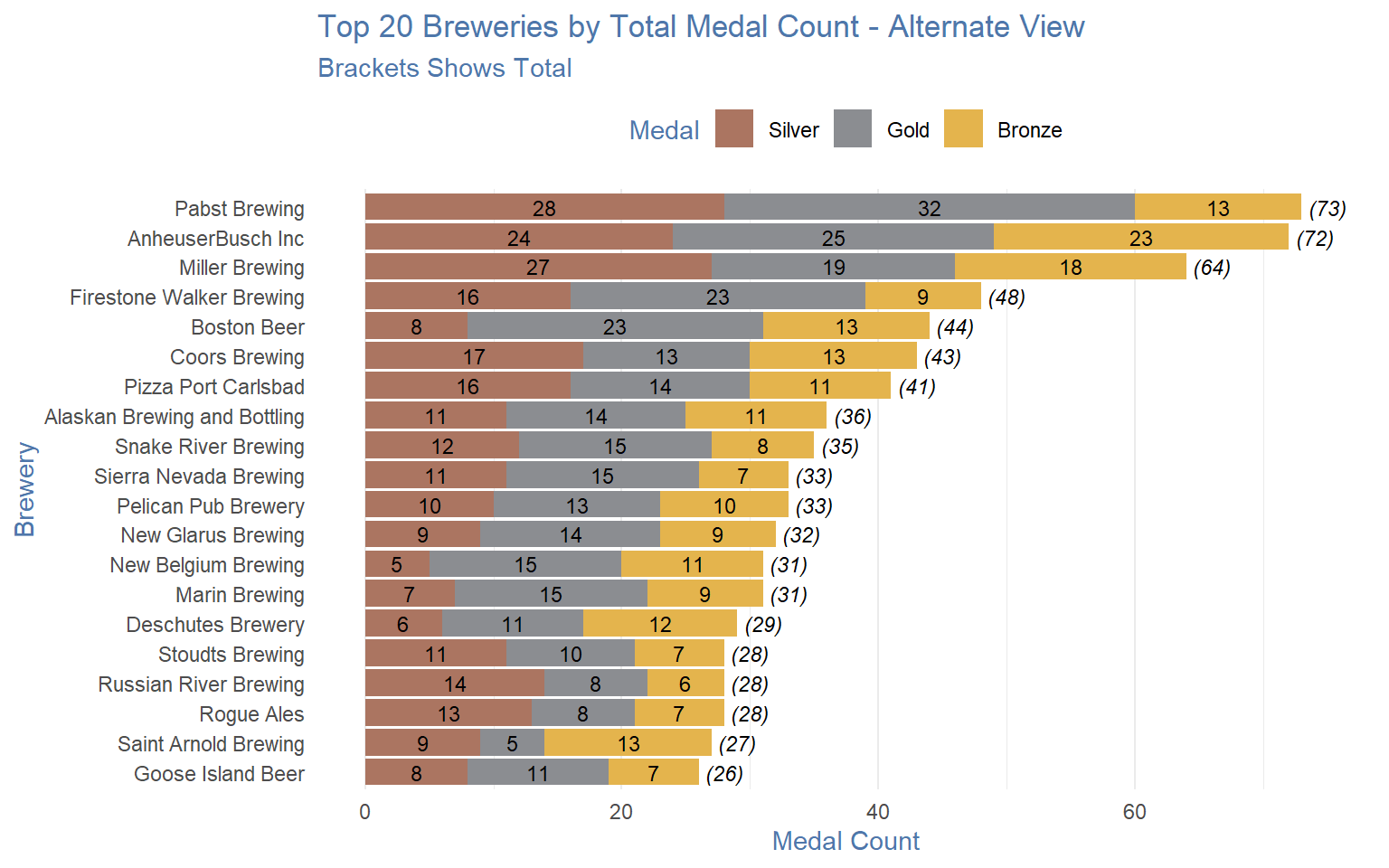
Pabst Brewing
Let’s explore Pabst a bit. Since 1844, Pabst creates and build iconic brands with deep ties to America’s heritage. Take some time to explore 175 years of brewing history.
For more than 150 years, Pabst Brewing Company has been a household name in the beer industry of the United States. Despite its impressive longevity, the company is currently in a difficult financial situation. Pabst has a contract with Miller Brewing Company that was set to expire in 2020, and Miller attempted to terminate it. In response, Pabst filed a $400 million lawsuit against MillerCoors. Although the jury was unable to reach a decision, the two sides agreed to a settlement, allowing Pabst to continue its joint operations. The primary issue in the case is the fact that Pabst has not been able to compete effectively with MillerCoors advertising budgets. The company has continued to advertise despite Miller’s budget constraints. Pabst appears to have been overwhelmed by the competition in the beer market. It’s unclear what the future holds for the once-beloved brand. While the settlement with MillerCoors has allowed Pabst to remain solvent for the time being, it is clear that the company must improve its marketing tactics in order to remain relevant in the long run.
| Pabst Brewing Co. | |||
| Who would have thought this brewery would still be doing so well? | |||
| Medal | Beer Name | Category | Style |
|---|---|---|---|
| 2017 | |||
| Silver | Pabst Blue Ribbon PBR | Standard American Beer | American Lager |
| 2016 | |||
| Silver | Old Style Lager | Standard American Beer | Cream Ale |
| Gold | Pabst Blue Ribbon PBR | Standard American Beer | American Lager |
| 2015 | |||
| Gold | Rainier Lager | Standard American Beer | Cream Ale |
| Silver | Olympia | Standard American Beer | Cream Ale |
| 2014 | |||
| Gold | Primo | Standard American Beer | Cream Ale |
| Silver | Old Style | Standard American Beer | Cream Ale |
| 2013 | |||
| Silver | Old Style | Standard American Beer | Cream Ale |
| Bronze | Rainier | Standard American Beer | Cream Ale |
| Bronze | Special Export | Standard American Beer | American Lager |
| 2012 | |||
| Gold | Pabst Blue Ribbon | Standard American Beer | American Lager |
| Silver | Old Style | Standard American Beer | American Lager |
| 2011 | |||
| Gold | Old Milwaukee Light | Standard American Beer | American Lager |
| Bronze | Pabst Blue Ribbon Light | Standard American Beer | American Lager |
| Silver | Rainier | Standard American Beer | American Lager |
| Bronze | Old Style | Standard American Beer | American Lager |
| 2010 | |||
| Silver | Old Milwaukee | Standard American Beer | American Lager |
| Silver | Rainier | Standard American Beer | American Lager |
| Bronze | Old Style | Standard American Beer | American Lager |
| 2008 | |||
| Silver | Old Milwaukee Light | Standard American Beer | American Light Lager |
| Gold | Lone Star | Standard American Beer | Cream Ale |
| Gold | Olympia | Standard American Beer | American Lager |
| Silver | Blatz | Standard American Beer | American Lager |
| 2007 | |||
| Gold | Lone Star | Standard American Beer | Cream Ale |
| Silver | Old Style | Standard American Beer | Cream Ale |
| Gold | Old Milwaukee Light | Standard American Beer | American Light Lager |
| Silver | Pabst Blue Ribbon Light | Standard American Beer | American Light Lager |
| 2006 | |||
| Silver | Lone Star | Standard American Beer | Cream Ale |
| Gold | Pabst Blue Ribbon | Standard American Beer | American Lager |
| Bronze | Blatz | Standard American Beer | American Lager |
| Gold | Old Milwaukee Light | Standard American Beer | American Light Lager |
| 2005 | |||
| Bronze | Special Export | Standard American Beer | Cream Ale |
| Gold | Stag | Standard American Beer | American Lager |
| Silver | Rainier | Standard American Beer | American Lager |
| Gold | Old Milwaukee Light | Standard American Beer | American Light Lager |
| Gold | Pabst Blue Ribbon | Standard American Beer | American Lager |
| Silver | Olympia | Standard American Beer | American Lager |
| 2004 | |||
| Silver | Special Export | Standard American Beer | American Lager |
| Gold | Old Milwaukee | Standard American Beer | American Lager |
| Bronze | Schlitz | Standard American Beer | American Lager |
| Gold | Rainier Light | Standard American Beer | American Light Lager |
| Silver | Old Milwaukee Light | Standard American Beer | American Light Lager |
| Bronze | Pabst Blue Ribbon | Standard American Beer | American Lager |
| Silver | Schlitz Malt Liquor | Specialty Beer | Mixed-Style Beer |
| Bronze | St Ides Malt Liquor | Specialty Beer | Mixed-Style Beer |
| Gold | Old Milwaukee NA | Specialty Beer | Experimental Beer |
| 2003 | |||
| Bronze | Old Style | Standard American Beer | American Lager |
| Gold | Old Milwaukee | Standard American Beer | American Lager |
| Silver | Rainier | Standard American Beer | American Lager |
| Gold | Old Style Light | Standard American Beer | American Light Lager |
| Bronze | Old Milwaukee Light | Standard American Beer | American Light Lager |
| 2000 | |||
| Silver | Pabst NA | Specialty Beer | Experimental Beer |
| 1998 | |||
| Silver | Pabst Genuine Draft Light | Standard American Beer | American Light Lager |
| Gold | Pabst NA | Specialty Beer | Experimental Beer |
| 1997 | |||
| Gold | Olde English Malt Liquor | Specialty Beer | Mixed-Style Beer |
| Gold | Pabst NA | Specialty Beer | Experimental Beer |
| 1996 | |||
| Silver | Pabst Blue Ribbon | Standard American Beer | American Lager |
| Gold | Pabst Genuine Draft Light | Standard American Beer | American Light Lager |
| 1995 | |||
| Gold | Pabst Genuine Draft Light | Standard American Beer | American Light Lager |
| Gold | Olde English 800 | Alternative Fermentables Beer | Alternative Grain Beer |
| Gold | Olympia Dry | Standard American Beer | American Lager |
| 1994 | |||
| Silver | Olympia Dry | Standard American Beer | American Lager |
| Gold | Pabst Genuine Draft Light | Standard American Beer | American Light Lager |
| Gold | Olde English 800 | Alternative Fermentables Beer | Alternative Grain Beer |
| 1993 | |||
| Gold | Olympia Dry | Standard American Beer | American Lager |
| Bronze | Pabst NonAlcoholic | Specialty Beer | Mixed-Style Beer |
| 1992 | |||
| Silver | Olympia Dry | Standard American Beer | American Lager |
| Silver | Hamms | Standard American Beer | American Lager |
| Gold | Olde English 800 Malt Liquor | Alternative Fermentables Beer | Alternative Grain Beer |
| 1991 | |||
| Gold | Pearl Lager Beer | Standard American Beer | American Lager |
| Gold | Old English 800 | Alternative Fermentables Beer | Alternative Grain Beer |
| 1990 | |||
| Silver | Pabst Blue Ribbon | Standard American Beer | American Lager |
| Silver | Olde English 800 | Alternative Fermentables Beer | Alternative Grain Beer |
Fewest Wins - One Time Winners
Below are the oldest one-hit-wonders awarded only one GABF Medal to date. Top (or is it bottom) 10 breweries displayed.
| Brewers with One GABF Medal to Date | |||||
| This does not mean they don't brew great beer. | |||||
| Beer Name | Brewery | City | State | Category | Style |
|---|---|---|---|---|---|
| 1984 | |||||
| New Amsterdam Amber | Old New York Brewing | New York | NY | Amber and Brown American Beer | American Amber Ale |
| 1986 | |||||
| Festival Ale | Boulder Brewing | Boulder | CO | Pale Malty European Lager | Festbier |
| 1987 | |||||
| St Stans Dark Alt | Stanislaus Area Association | Modesto | CA | Amber Bitter European Beer | Altbier |
| Chesbay Double Bock | Chesapeake Bay Brewing | Raleigh | NC | Amber Malty European Lager | Dunkles Bock |
| Golden Bear Dark Malt | Thousand Oaks Brewing | Berkeley | CA | Amber and Brown American Beer | American Amber Ale |
| Yuengling Porter | D G Yuengling Son Inc | Tampa | FL | American Porter and Stout | American Porter |
| Vienna Style Lager | Vienna Brewing | Milwaukee | WI | Amber Bitter European Beer | Vienna Lager |
| Du Bru Ale | Saxton Brewery | Chico | CA | Standard American Beer | American Wheat Beer |
| 1988 | |||||
| Darryls Original Premium Lager Beer | Gilbert Robinson Inc | Kansas City | MO | Historical Beer | Pre-Prohibition Lager |
| Ambier | Ambier Brewing | Milwaukee | WI | Amber Malty European Lager | Marzen |
I have enjoyed the Dunkle brewed by Chesapeake Brewing Company. It is SO unfortunate this brewery closed many years ago to make room for a cultural museum. The museum attracts few visitors - the brewery always enjoyed a kind and happy crowd!
Competitions - Analyze by States
So far the GABF Competition has been viewed from the brewery point of view. Let’s shift and examine how beer competition data looks when viewed by US/State geography.
To bridge into this topic, let’s first look at the top award winning breweries and add the State information to see where these breweries are located. Note the large breweries have brew operations in many states. I this case, the corporate location is used.
Yes this looks like the same plot used earlier, just a bit prettier and with the added state labels. Forgive my reduncdancy!
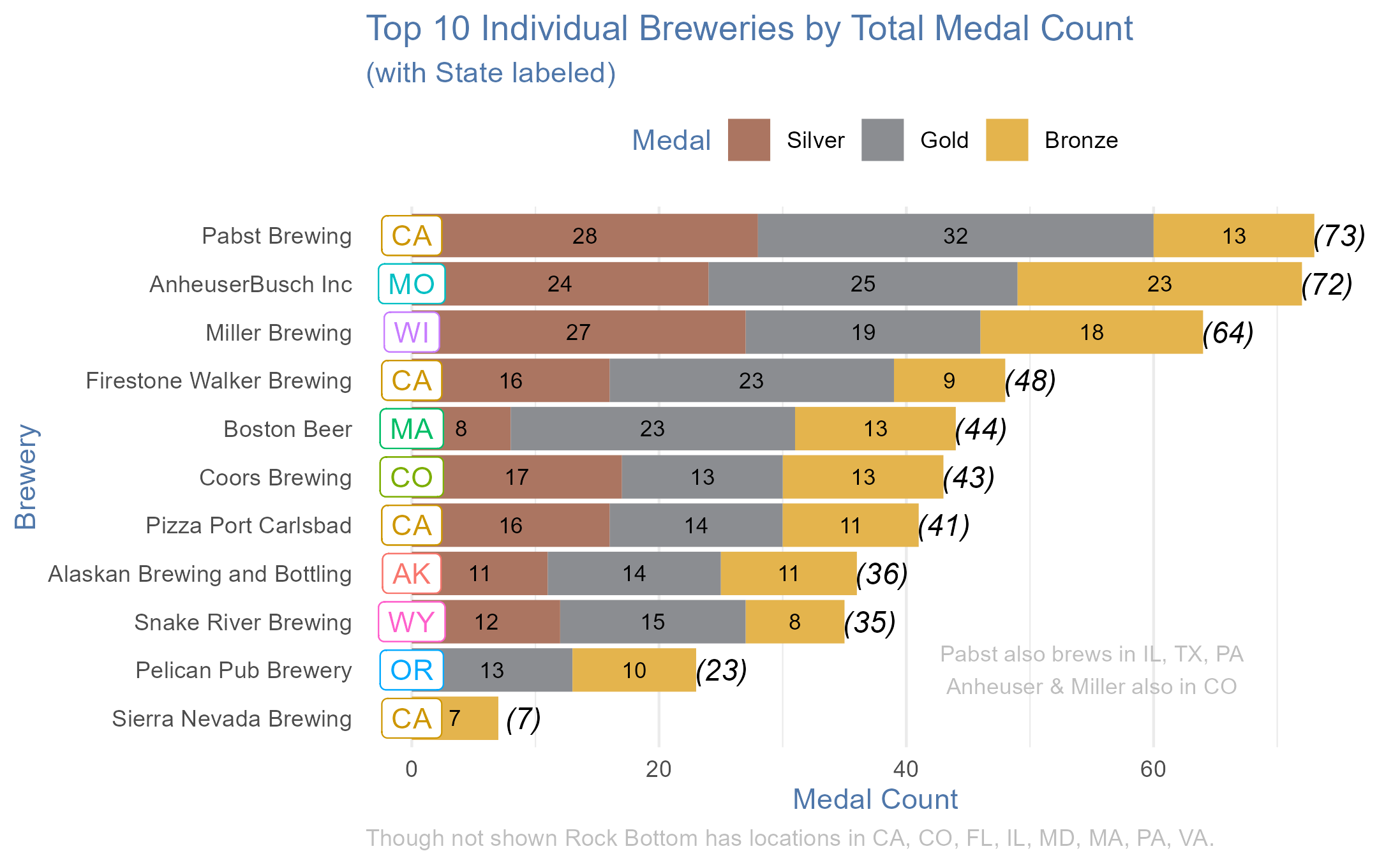 Pabst drives CA to the top of the charts followed by MO as a result of Anheuser Busch. California leads the pack. In addition to Pabst, Firestone Walker, Pizza Port, and Sierra Nevada are also in California.
Pabst drives CA to the top of the charts followed by MO as a result of Anheuser Busch. California leads the pack. In addition to Pabst, Firestone Walker, Pizza Port, and Sierra Nevada are also in California.
State and National Beer Facts
So, how many breweries are there in the United States?
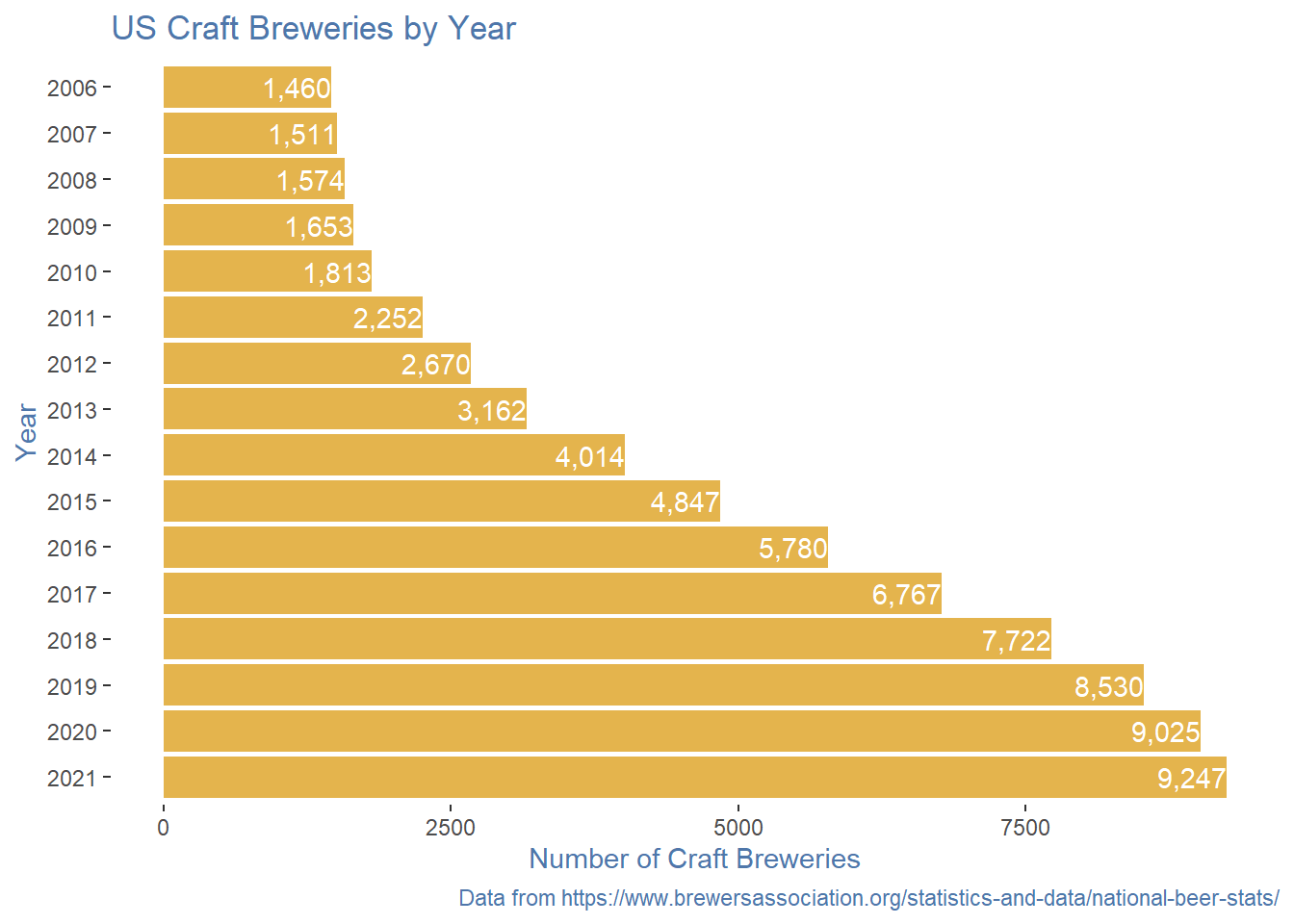
Over 9,000 breweries. SO glad I do not collect pint glasses any more!
Let’s examine some other State-specific beer facts! In addition to seeing the number of breweries for each state, the beer consumption in gallons/adult is also provided!
| State Craft Brewing Data | ||||
| Data Current as of 2021 | ||||
| X | State | Brewery Count1 | Gallons Consumed per Adult1 |
Gallons |
|---|---|---|---|---|
| 1 | Alabama | 52 | 0.7 | |
| 2 | Alaska | 53 | 9.9 | |
| 3 | Arizona | 121 | 1.2 | |
| 4 | Arkansas | 46 | 0.7 | |
| 5 | California | 931 | 3.7 | |
| 6 | Colorado | 428 | 6.8 | |
| 7 | Connecticut | 119 | 3.7 | |
| 8 | Delaware | 35 | 12.3 | |
| 9 | Florida | 374 | 2.5 | |
| 10 | Georgia | 155 | 2.2 | |
| 11 | Hawaii | 27 | 5.4 | |
| 12 | Idaho | 83 | 2.3 | |
| 13 | Illinois | 299 | 1.4 | |
| 14 | Indiana | 203 | 1.6 | |
| 15 | Iowa | 108 | 1.9 | |
| 16 | Kansas | 66 | 0.6 | |
| 17 | Kentucky | 82 | 1.2 | |
| 18 | Louisiana | 44 | 2.3 | |
| 19 | Maine | 143 | 10.5 | |
| 20 | Maryland | 125 | 2.0 | |
| 21 | Massachusetts | 194 | 3.0 | |
| 22 | Michigan | 408 | 3.5 | |
| 23 | Minnesota | 226 | 4.6 | |
| 24 | Mississippi | 18 | 0.3 | |
| 25 | Missouri | 157 | 2.4 | |
| 26 | Montana | 105 | 7.7 | |
| 27 | Nebraska | 63 | 1.2 | |
| 28 | Nevada | 51 | 1.0 | |
| 29 | New Hampshire | 98 | 3.3 | |
| 30 | New Jersey | 141 | 1.0 | |
| 31 | New Mexico | 100 | 3.0 | |
| 32 | New York | 485 | 2.7 | |
| 33 | North Carolina | 364 | 3.8 | |
| 34 | North Dakota | 23 | 1.4 | |
| 35 | Ohio | 365 | 4.6 | |
| 36 | Oklahoma | 76 | 1.0 | |
| 37 | Oregon | 310 | 8.6 | |
| 38 | Pennsylvania | 486 | 10.3 | |
| 39 | Rhode Island | 37 | 3.3 | |
| 40 | South Carolina | 129 | 1.0 | |
| 41 | South Dakota | 42 | 1.1 | |
| 42 | Tennessee | 141 | 1.2 | |
| 43 | Texas | 406 | 1.7 | |
| 44 | Utah | 40 | 2.2 | |
| 45 | Vermont | 74 | 24.2 | |
| 46 | Virginia | 314 | 2.0 | |
| 47 | Washington | 437 | 3.1 | |
| 48 | West Virginia | 29 | 0.6 | |
| 49 | Wisconsin | 230 | 5.9 | |
| 50 | Wyoming | 45 | 4.8 | |
| 1 Data collected from Brewers Association | ||||
I don’t know about you, but I need to spend more time in Vermont - over 24 gallons of beer for everyone! Conversely, you might want to skip Mississippi, Kansas, West Virginia and Alabama. There’s not enough beer drinking there for me!
Lastly, below is an overview of the state of beer in the US. The data is provided by the Brewers Association. The market segments in the table are defined below too.
| U.S. Brewery Count | ||||||||
| Courtesy of Brewers Association | ||||||||
| Market Segments | 2015 | 2016 | 2017 | 2018 | 2019 | 2020 | 2021 | 2020/21 Change |
|---|---|---|---|---|---|---|---|---|
| Craft | 4,803 | 5,713 | 6,661 | 7,618 | 8,419 | 8,905 | 9,118 | 4.4% |
| Regional Craft Breweries | 178 | 186 | 202 | 230 | 240 | 220 | 223 | 1.4% |
| Microbreweries | 2,684 | 3,319 | 3,956 | 4,518 | 1,917 | 1,898 | 1,886 | -0.6% |
| Taprooms | 3,091 | 3,471 | 3,708 | 6.2% | ||||
| Brewpubs | 1,941 | 2,208 | 2,503 | 2,870 | 3,171 | 3,302 | 3,307 | 0.2% |
| Large/Non-Craft | 44 | 67 | 106 | 104 | 111 | 120 | 129 | 7.5% |
| Total U.S. Breweries | 4,847 | 5,780 | 6,767 | 7,722 | 8,530 | 9,025 | 9,247 | 2.5% |
Brewer’s Association Market Definitions
Craft Beer Industry Market Segments
Craft The Brewers Association defines a craft brewer as a small and independent brewer. Small: Annual production of 6 million barrels of beer or less (approximately 3 percent of U.S. annual sales). Beer production is attributed to a brewer according to rules of alternating proprietorships. Independent: Less than 25 percent of the craft brewery is owned or controlled (or equivalent economic interest) by a beverage alcohol industry member that is not itself a craft brewer.
The following are some concepts related to craft beer and craft brewers:
- Craft brewers are small brewers
- The hallmark of craft beer and craft brewers is innovation. Craft brewers interpret historic styles with unique twists and develop new styles that have no precedent
- Craft beer is generally made with traditional ingredients like malted barley; interesting and sometimes non-traditional ingredients are often added for distinctiveness
- Craft brewers tend to be very involved in their communities through philanthropy, product donations, volunteerism and sponsorship of events
- Craft brewers have distinctive, individualistic approaches to connecting with their customers
- Craft brewers maintain integrity by what they brew and their general independence, free from a substantial interest by a non-craft brewer
- The majority of Americans live within 10 miles of a craft brewer
Microbrewery A brewery that produces less than 15,000 barrels of beer per year and sells 75 percent or more of its beer off-site. Microbreweries sell to the public by one or more of the following methods: the traditional three-tier system (brewer to wholesaler to retailer to consumer); the two-tier system (brewer acting as wholesaler to retailer to consumer); and directly to the consumer through carry-outs and/or on-site taproom or restaurant sales.
Brewpub A restaurant-brewery that sells 25 percent or more of its beer on-site and operates significant food services. The beer is brewed primarily for sale in the restaurant and bar, and is often dispensed directly from the brewery’s storage tanks. Where allowed by law, brewpubs often sell beer to-go and/or distribute to off-site accounts.
Taproom Brewery A professional brewery that sells 25 percent or more of its beer on-site and does not operate significant food services. The beer is brewed primarily for sale in the taproom, and is often dispensed directly from the brewery’s storage tanks. Where allowed by law, taproom breweries often sell beer to-go and/or distribute to off-site accounts.
Regional Brewery A brewery with an annual beer production of between 15,000 and 6,000,000 barrels.
Contract Brewing Company A business that hires another brewery to produce its beer. It can also be a brewery that hires another brewery to produce additional beer. The contract brewing company handles marketing, sales, and distribution of its beer, while generally leaving the brewing and packaging to its producer-brewery (which is also sometimes referred to as a contract brewery).
Medal Analysis
There are many ways to display this information. I have selected a few below that I hope provide you insights that may even offer a few surprises.
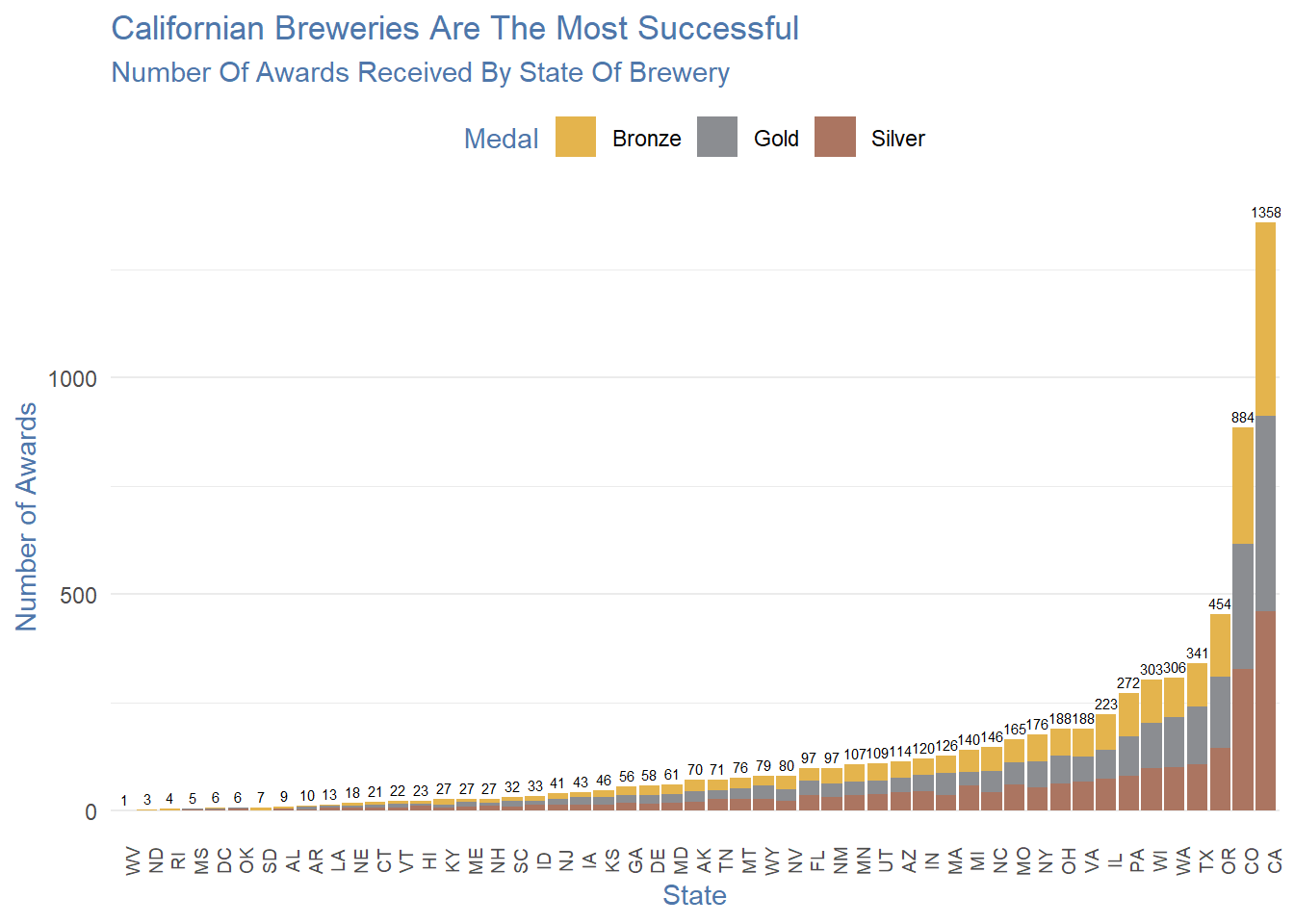
Given the population of California, it is not too surprising that they have the most breweries providing them greater opportunities to win recognition. CA, CO, OR, TX, and WA have the most breweries and have won the most medals.
Here’s a different view of the same data.

We already learned there were 9,247 craft breweries in 2021. At the 2021 GABF Competition, 266 breweries won. Also, a total of 9,860 competition entries were submitted from 2,192 breweries (425 were new breweries). (Data found here.) Roughly, this translates to approximately 24% of craft breweries in the US participated in the GABF in 2021! Pretty impressive.
| Brewery Participation in 2021 | |||
| State | Breweries Entered | Breweries1 | Percentage |
|---|---|---|---|
| CA | 56 | 931 | 6.0% |
| CO | 20 | 428 | 4.7% |
| OR | 15 | 310 | 4.8% |
| TX | 10 | 406 | 2.5% |
| WA | 21 | 437 | 4.8% |
| 1 Source: https://www.brewersassociation.org/statistics-and-data/state-craft-beer-stats/ | |||
It is not surprising that California was won the most GABF awards given it population. The higher the population, the larger the market for breweries. This leads to more changes for an award during competitions.
We have also learned that the state with the most breweries have won the most awards in GABF Competitions. However, is this really fair? Many of these states have large populations. Let’s evaluate the data by including state populations to normalize the competition results.
Medal Wins Normalized by State Population
Below there are lots of interesting beer facts!
- Per capita, Wyoming has won the most awards!
- Kansas, when it wins, it is awarded more gold and silver medals on average followed by Iowa, Maine, South Carolina, and Wyoming!
- Tennessee appears to win more bronze awards on average compared to the other states.
| State Awards Revisted | ||||
| Awards Adjusted for State Population (Population Data from 2015) | ||||
| State Name | Total Medals | Population per 100,000 | Awards per Capita | Average Medal Awarded1 |
|---|---|---|---|---|
| Wyoming | 27 | 5.77 | 2.15 | |
| Colorado | 261 | 57.74 | 2.06 | |
| Oregon | 149 | 42.37 | 2.01 | |
| Montana | 36 | 10.84 | 2.06 | |
| New Mexico | 42 | 21.18 | 1.98 | |
| Washington | 127 | 77.05 | 2.06 | |
| California | 532 | 395.38 | 1.98 | |
| Nevada | 33 | 31.05 | 1.97 | |
| North Carolina | 103 | 104.39 | 1.96 | |
| Virginia | 83 | 86.31 | 1.99 | |
| Indiana | 63 | 67.86 | 1.92 | |
| Minnesota | 51 | 57.06 | 2.02 | |
| Maine | 12 | 13.62 | 2.25 | |
| Iowa | 26 | 31.90 | 2.27 | |
| Ohio | 87 | 117.99 | 2.06 | |
| Idaho | 12 | 18.39 | 1.83 | |
| Utah | 21 | 32.72 | 1.86 | |
| Illinois | 80 | 128.13 | 1.81 | |
| Wisconsin | 35 | 58.94 | 1.97 | |
| Missouri | 33 | 61.55 | 2.00 | |
| Michigan | 53 | 100.77 | 1.83 | |
| Texas | 126 | 291.46 | 2.09 | |
| Kansas | 12 | 29.38 | 2.42 | |
| Pennsylvania | 53 | 130.03 | 1.91 | |
| Arizona | 29 | 71.52 | 2.03 | |
| Connecticut | 13 | 36.06 | 1.92 | |
| South Carolina | 18 | 51.18 | 2.22 | |
| Massachusetts | 21 | 70.30 | 1.90 | |
| Florida | 56 | 215.38 | 2.07 | |
| Tennessee | 16 | 69.11 | 1.69 | |
| Georgia | 22 | 107.12 | 1.82 | |
| New Jersey | 18 | 92.89 | 1.89 | |
| New York | 35 | 202.01 | 1.91 | |
| 1 Gold = 3, Silver = 2, Bronze = 1. This is how the average Medal Awarded was calculated. | ||||
Colorado is a great state for beer, but I would not expect it to be distinguished as a clear leader among the states (it’s #2 above). I suspect there is skew in the number of awards won by state because the festival is always held in Denver. Breweries located closer to Denver are more likely to participate.
A different way to look at the award winning states compared to the state populations is illustrated below..
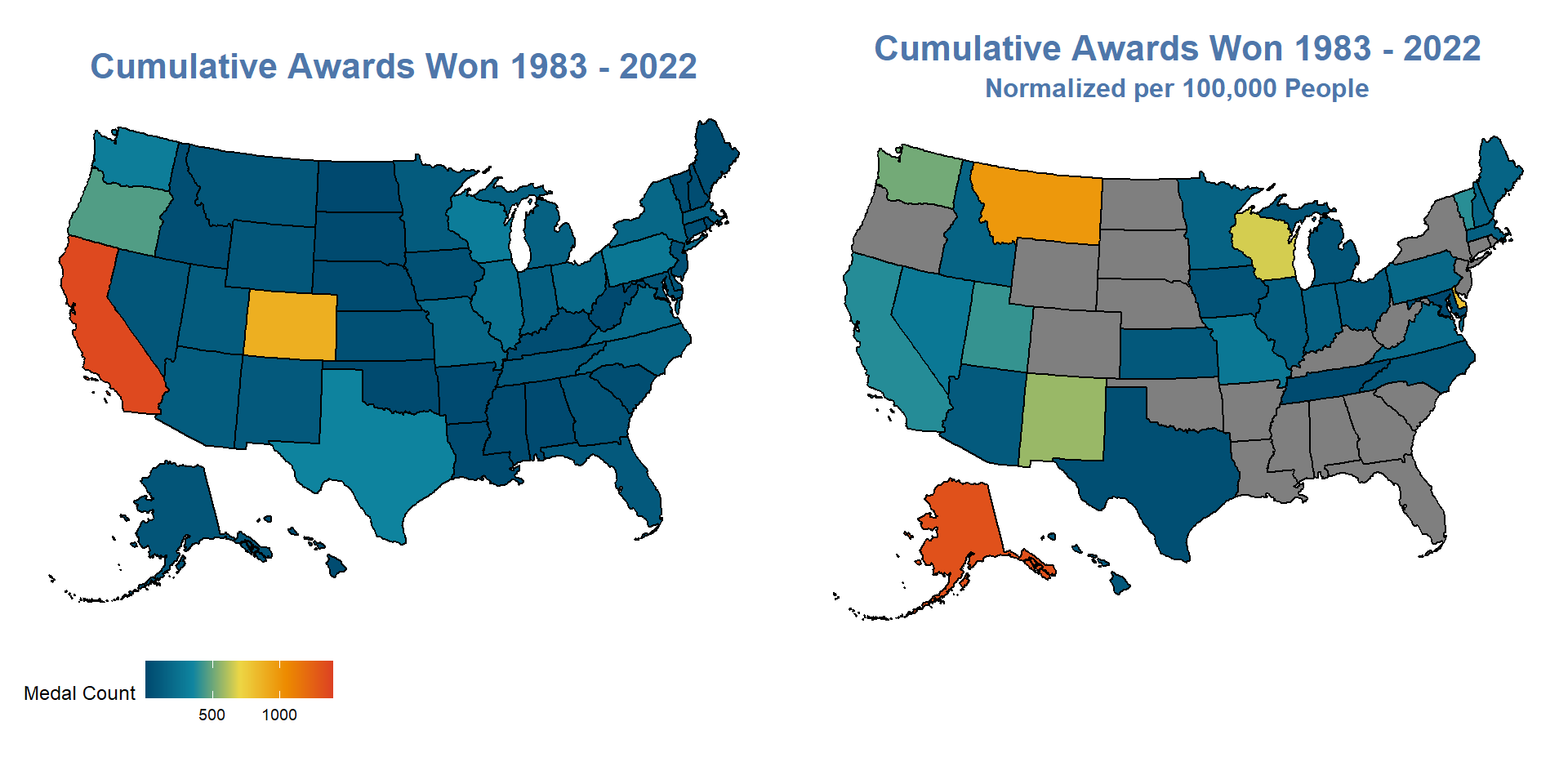
Note in the left map how California is red but when normalized by the state’s large population, the color changes dramatically. The reverse logic applied to Alaska.
If you prefer animated maps, enjoy the visualizations below.
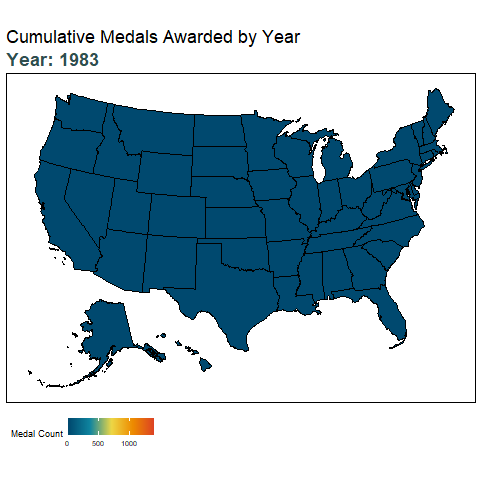

Lastly, if you are curious where the breweries are, below is an interactive map comparing 2022 and all previous years.
States Starting to Lead
I mentioned in the beginning of this document, I like data. Well, let’s take this analysis to a whole other level! Let’s use the data we have, add in a bit of statistics and machine learning, and forecast the states that are starting to take the lead in winning GABF Medals! (For those interested, a simple binomial generalized linear model is used to create the analysis below.)
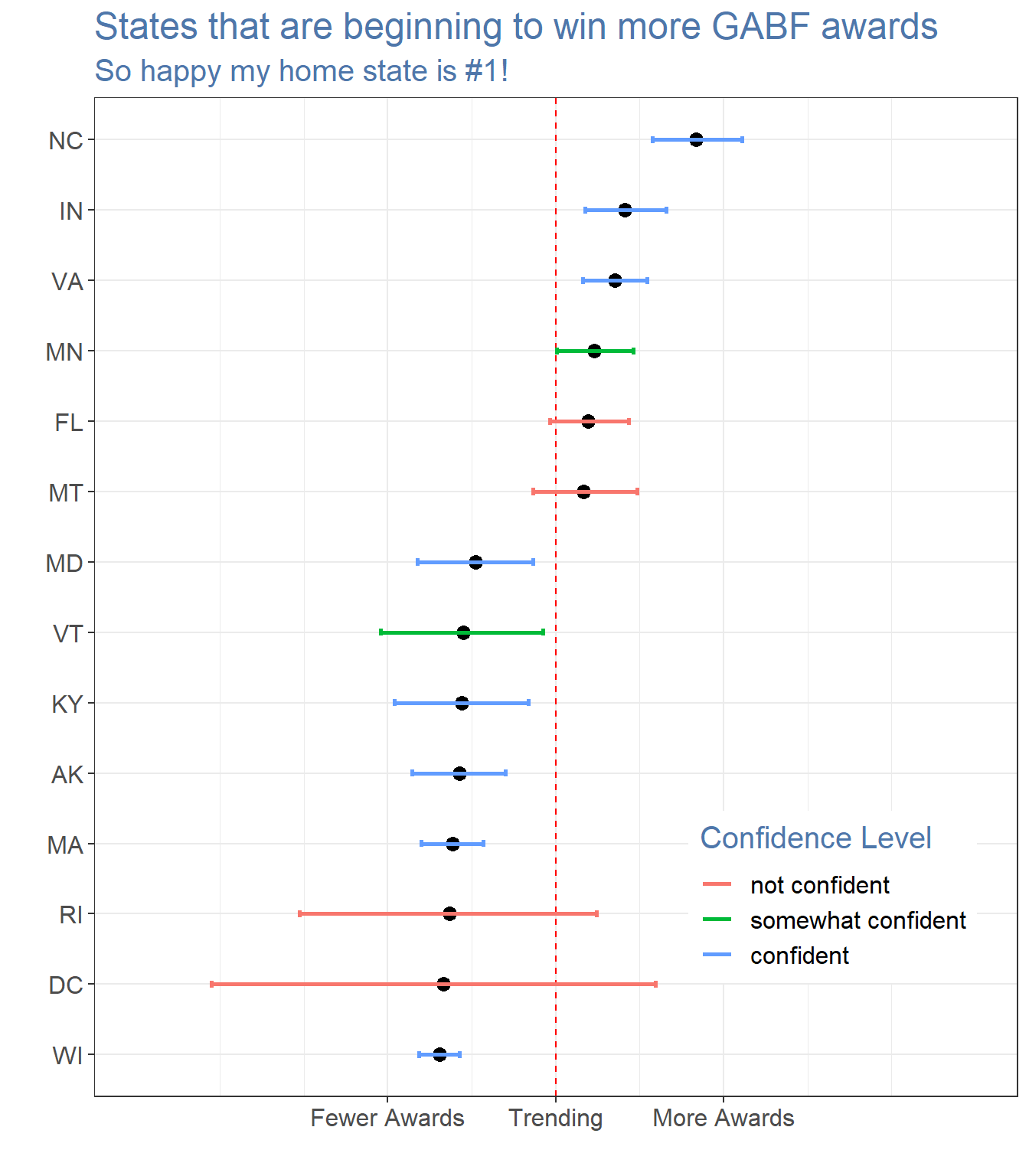
This tells us that North Carolina - where I live - is the state more likely to win more GABF medals in the future! Go NC!
Pretty cool, huh?
Most Awarded Beers
So far we have learned much about beer competitions and which breweries are successful, which states produce the most beer, and which have been fortunate to win lots of medals. Next, let’s shift the focus to winning beers!
| Most Awarded Beers of All Time | ||||
| I LOVE that Alaskan Brewery has done so well. I love that place! | ||||
| Beer Name | Brewery | City | State | Medals Won |
|---|---|---|---|---|
| Alaskan Smoked Porter | Alaskan Brewing and Bottling | Juneau | AK | 12 |
| Laughing Lab Scottish Ale | Bristol Brewing | Colorado Springs | CO | 10 |
| Samuel Adams Double Bock | Boston Beer | Boston | MA | 9 |
| Abbey Belgian Style Ale | New Belgium Brewing | Fort Collins | CO | 8 |
| Coors Light | Coors Brewing | Golden | CO | 8 |
| Miller Genuine Draft | Miller Brewing | Milwaukee | WI | 8 |
| Raspberry Tart | New Glarus Brewing | New Glarus | WI | 8 |
| Genesee Cream Ale | GeneseeHigh Falls Brewing | Rochester | NY | 7 |
| Kiwanda Cream Ale | Pelican Pub Brewery | Pacific City | OR | 7 |
| ODouls | AnheuserBusch Inc | Saint Louis | MO | 7 |
Alaskan Smoked Porter has 12 medals. Impressive!
Explore Alaskan Smoked Porter Success
| Alaskan Smoked Porter GABF Medals | |
| Medal | Count |
|---|---|
| Gold | 5 |
| Bronze | 4 |
| Silver | 3 |

While Alaskan Porter has been very successful, most of its success was in the 1990s. I’d like to see this beer win another medal soon.
Other Award Winning Beers

We see see how the top awarding winning beers performed over time. Samuel Adams Double Bock performed very well and was the second best beer crafted by an individual brewery, it won the most amount of gold medals. W
What! O’Douls? It embarrasses me that a non-alcoholic is in this list. I do not have a problem with NA beer. While it does not excite me, I’d prefer to see a more traditional beer style take its place.Because O’Douls is brewed by AnheuserBusch, I should have known this before this point in my analysis!
What about Pabst?
We know Pabst Brewing has won more medals than any other brewer. We explored this in detail earlier. So why doesn’t Pabst show up in the list of the most award winning beers? Let’s take a look.
| Pabst Brewing Revisited | |
| How Did the Brands Do Individually? | |
| Medal | Medal Count |
|---|---|
| Old Style | |
| Silver | 4 |
| Bronze | 3 |
| Old Milwaukee Light | |
| Gold | 4 |
| Silver | 2 |
| Bronze | 1 |
| Pabst Blue Ribbon | |
| Gold | 3 |
| Bronze | 1 |
| Silver | 2 |
| Rainier | |
| Bronze | 1 |
| Silver | 4 |
| Pabst Genuine Draft Light | |
| Silver | 1 |
| Gold | 3 |
| Olympia Dry | |
| Gold | 2 |
| Silver | 2 |
| Olympia | |
| Silver | 2 |
| Gold | 1 |
| Special Export | |
| Bronze | 2 |
| Silver | 1 |
| Old Milwaukee | |
| Silver | 1 |
| Gold | 2 |
| Lone Star | |
| Gold | 2 |
| Silver | 1 |
| Pabst NA | |
| Silver | 1 |
| Gold | 2 |
| Olde English 800 | |
| Gold | 2 |
| Silver | 1 |
| Pabst Blue Ribbon PBR | |
| Silver | 1 |
| Gold | 1 |
| Pabst Blue Ribbon Light | |
| Bronze | 1 |
| Silver | 1 |
| Blatz | |
| Silver | 1 |
| Bronze | 1 |
| Old Style Lager | |
| Silver | 1 |
| Rainier Lager | |
| Gold | 1 |
| Primo | |
| Gold | 1 |
| Stag | |
| Gold | 1 |
| Schlitz | |
| Bronze | 1 |
| Rainier Light | |
| Gold | 1 |
| Schlitz Malt Liquor | |
| Silver | 1 |
| St Ides Malt Liquor | |
| Bronze | 1 |
| Old Milwaukee NA | |
| Gold | 1 |
| Old Style Light | |
| Gold | 1 |
| Olde English Malt Liquor | |
| Gold | 1 |
| Pabst NonAlcoholic | |
| Bronze | 1 |
| Hamms | |
| Silver | 1 |
| Olde English 800 Malt Liquor | |
| Gold | 1 |
| Pearl Lager Beer | |
| Gold | 1 |
| Old English 800 | |
| Gold | 1 |
Ok, this makes sense. Pabst has done remarkably well. Old Style and Old Milwaukee Light have both won 7 medals. This success simply was left out of the previous tables because I was attempting to keep the tables small. Sorry about that Pabst! Below I make up for it.
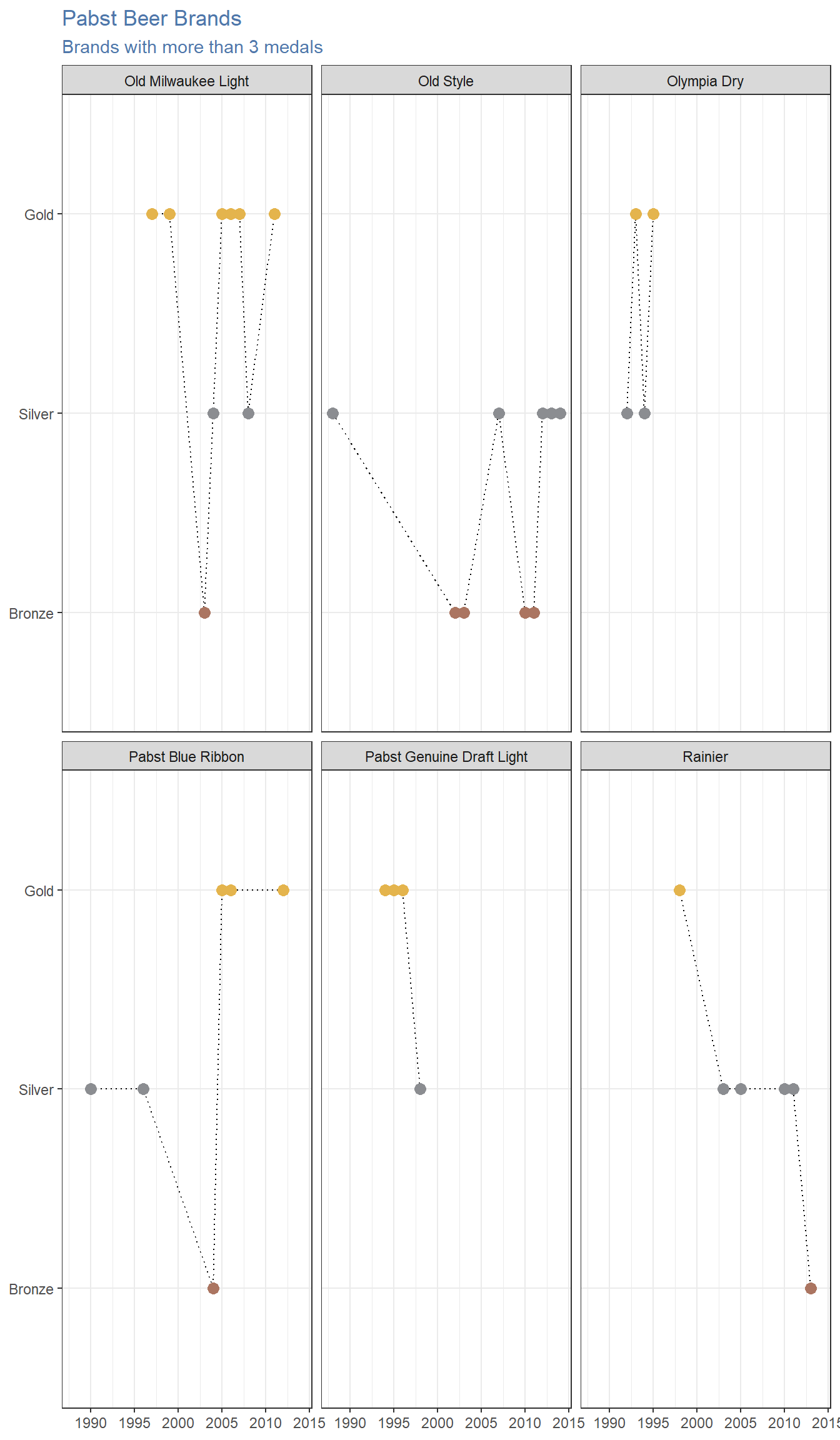
Changing Beer Preferences
Well, bad news, we are coming to an end to the GABF Medal Analysis. In this part we will examine how beer preferences are changing.
Below are several visualizations intended to show how beer preferences have changed over time.
I provide static plots where each one shows which types of beers were awarded the most. The slides are divided by decades. In the early years, American Style Beers, ambers, and lagers were most awarded. Specialty, Spiced and IPA Beers were not prominent. This clearly changed over the years!
Note the data below is based on BJCP Beer Categories.
 In the early years, craft brewers focused on American Style Beers - no surprise since the GABF is an American Festival! What is equally clear is how beer preferences change over time. Specialty and IPAs found there way to the top of the charts because so many breweries began developing this style to satisfy changing consumer tastes.
In the early years, craft brewers focused on American Style Beers - no surprise since the GABF is an American Festival! What is equally clear is how beer preferences change over time. Specialty and IPAs found there way to the top of the charts because so many breweries began developing this style to satisfy changing consumer tastes.
Below is an animated representation of the same data above. Perhaps you’ll like this illustration better.
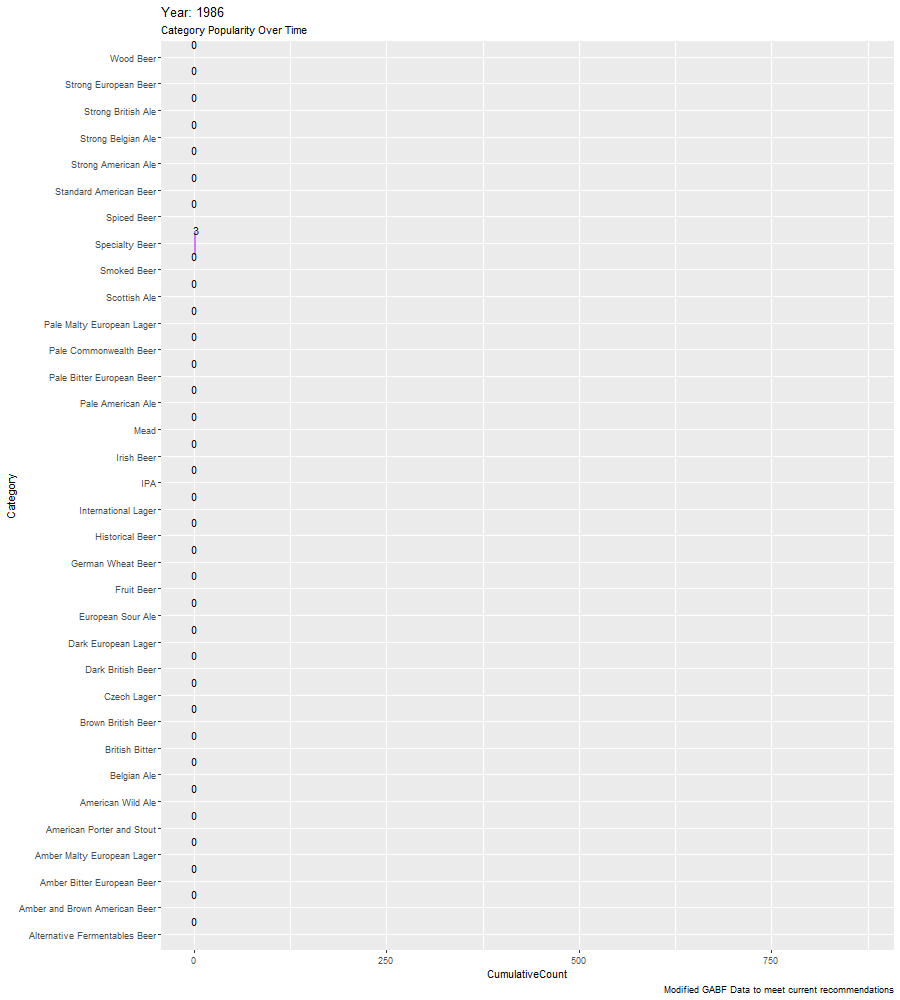
I took the animation above and attempted to re-envision it to improve the user experience. Because of the data, it is not perfect but this took a lot of time to produce so I publish it just so the time does not go wasted!
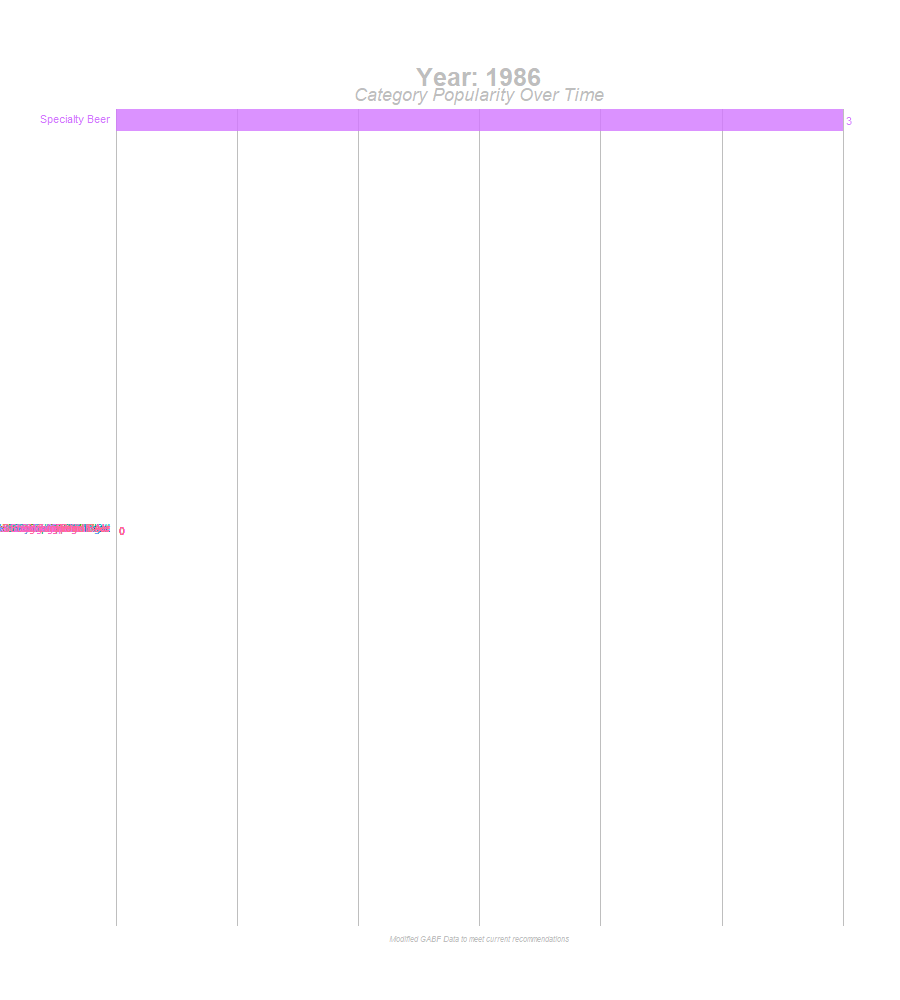
Continuing this analysis of changing beer preferences, a similar illustration is provided below but this time the plot is using BJCP Beer Styles rather than Beer Category data.
Beer Styles Over Time

In each of these visualizations, it is clear that IPAs have become very popular as have specialty beers. (Many of the specialty beers are derivatives of IPAs.)
IPA Growth
Let’s take a quick dive into the world of IPAs.

ipa_plt_gabf
It is clear that the public is enamored with IPAs. I personally think this style is over-hyped. Go into any store and IPAs dominate the store shelves at the sacrifice of all the other styles of beer.
Beer Styles - Simple Modeling
Let’s use some fundamental statistical analysis and modeling to answer a few questions. First, a brief introduction to weighted log odds - the statistical analysis approach used in developing this content. Don’t be worried, it is really pretty simple. If you are not interested, just skip this part.
Log Odds
Probability, odds ratios and log odds are all the same thing, just expressed in different ways. It’s similar to the idea of scientific notation: the number 1,000 can be written as
Probability is the probability an event happens. For example, there might be an 80% chance of rain today. Odds (more technically the odds of success) is defined as probability of success/probability of failure. So the odds of a success (80% chance of rain) has an accompanying odds of failure (20% chance it doesn’t rain); as an equation (the odds ratio), that’s
Got it? (If you don’t, no worries, read on!)
OK, now that you have an idea of log odds (or maybe you don’t and really don’t give a crap), let’s evaluate our first plot below.
Note that I have used otehr beer catergories other an BJCP. I had to do this because htere were not enough samples of all the beer styles so I had to collapse them into Beer Advocate and Brewers Association catergories.
We can learn something here - beer style preferences vary by state:
- Texas has an affinity for pale and dark lagers (so do I). IPAs are not as popular.
- California loves their IPAs and strong ales too.
- Wheat beers have a strong following in Colorado and Oregon.
While I have not verified this, I think this offers strong evidence that beer preferences vary across state boundaries. (If you want to challenge this, let me know and I’ll produce this data for every state.)
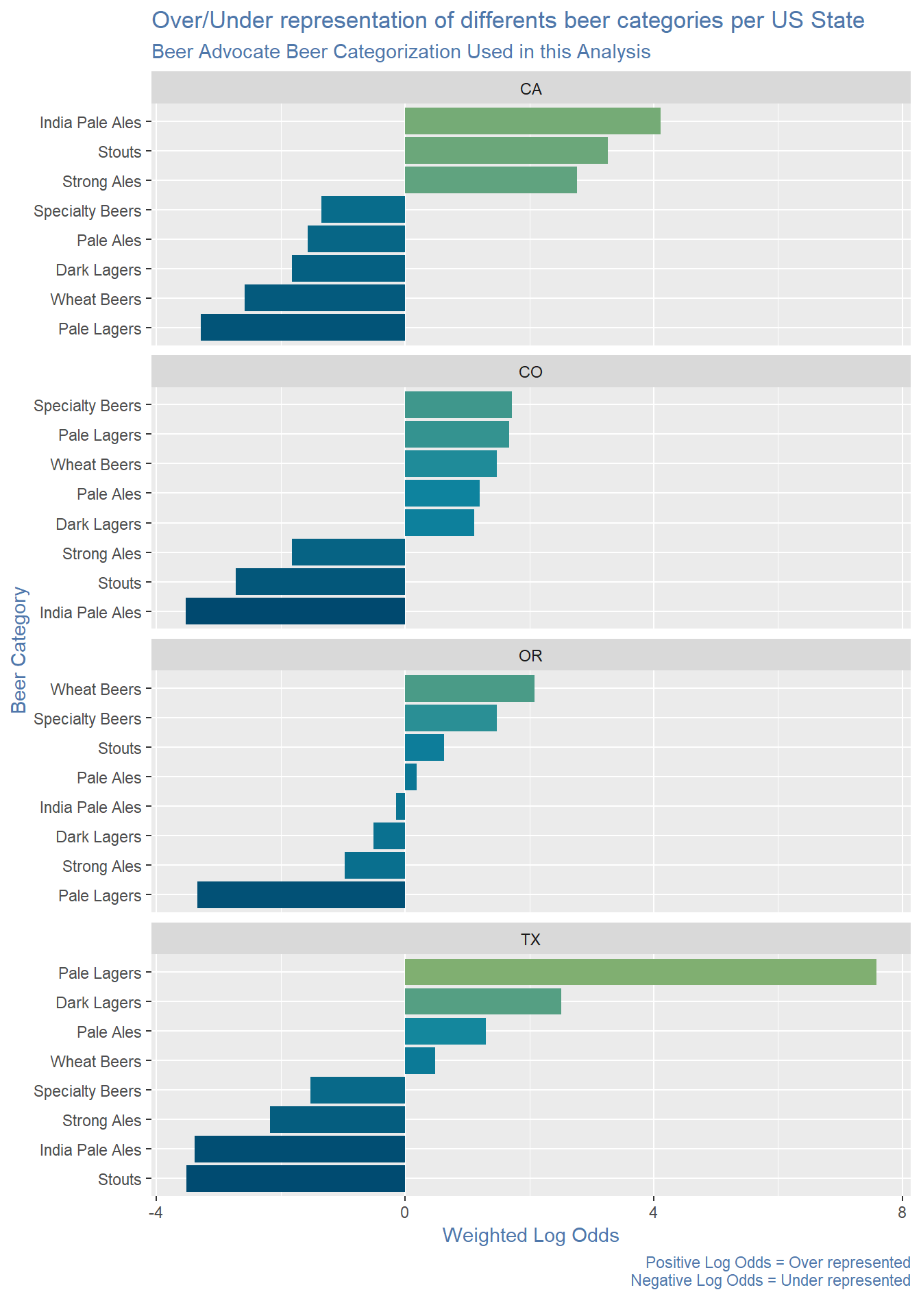
Below is the same data but beer was categorized by the Brewers Association Guidelines. Recall that North American Origin Ale Styles include a variety of BJCP categories including IPAs. While the results appear different, a closer examination will reveal the two analyses above are consistent. (I personally prefer the 1st analysis because it is more easily interpretable!)
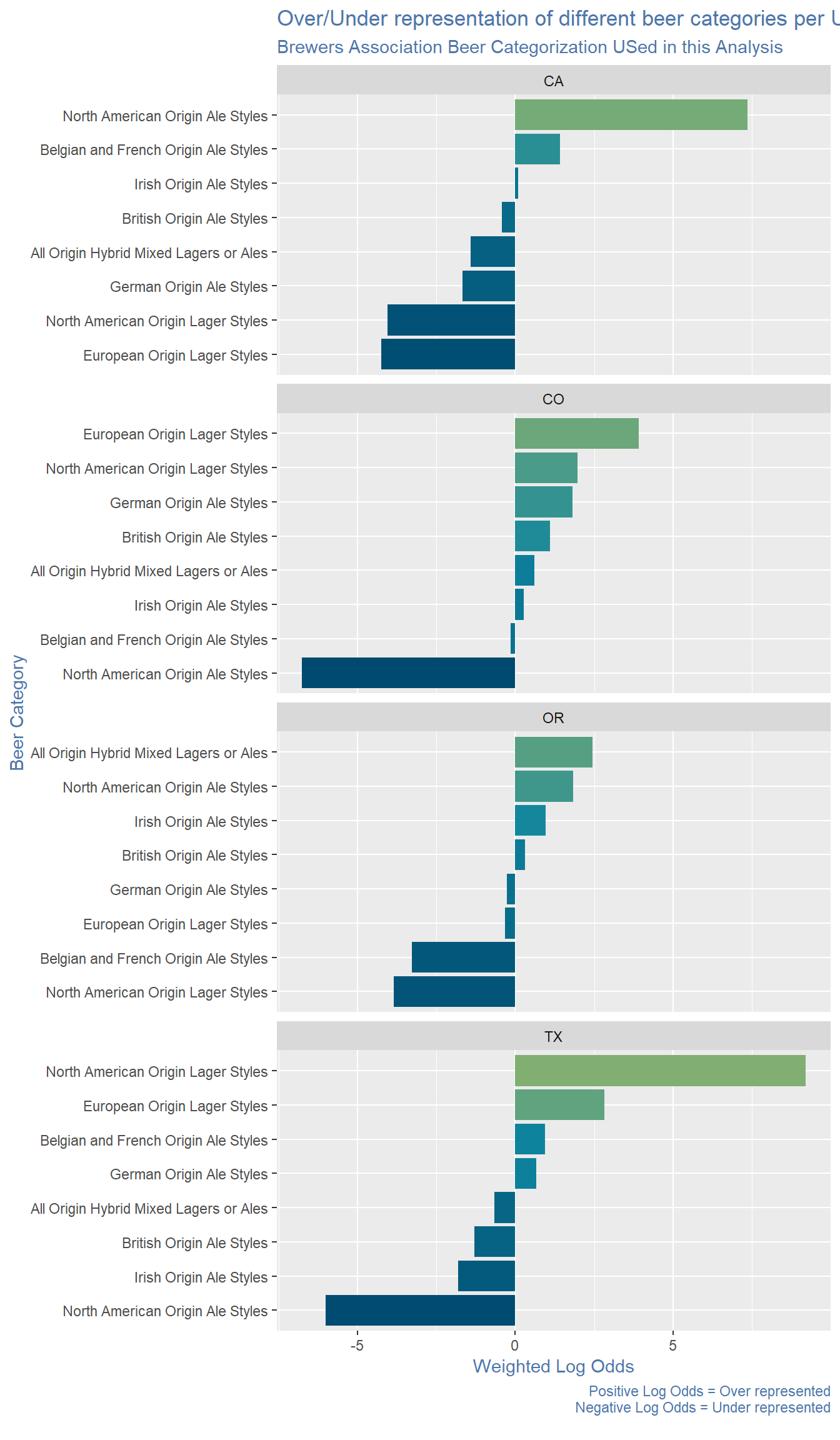
Using the Beer Advocate Guidelines, I amp of the US is provided below showing the beer preferences across the US. I love this visualization - hope you do too!
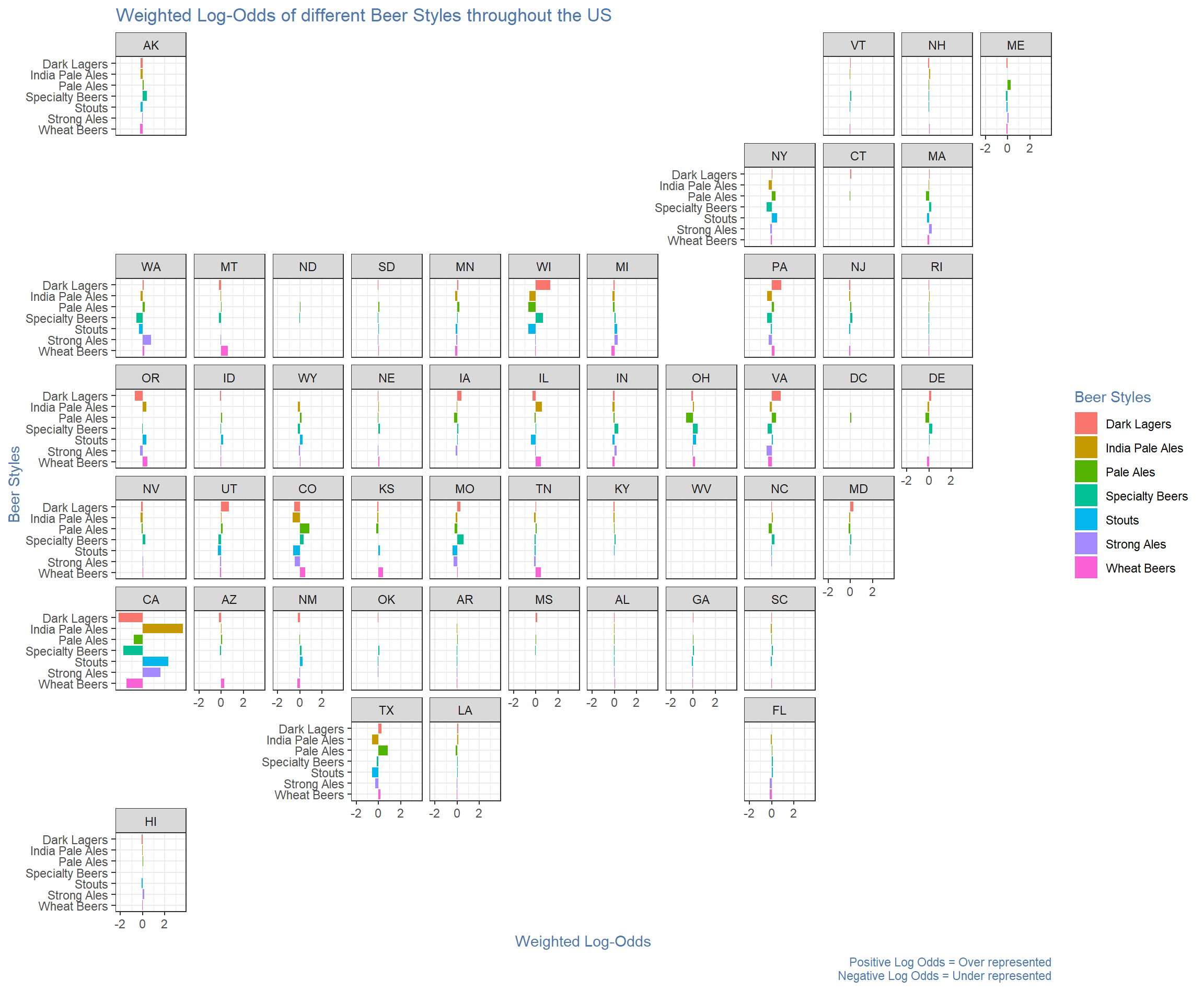
Dark lagers, a beer style I love, is popular in Wisconsin, Pennsylvania, Virginia, Utah, Texas, and a few other states. LOts to the learned from the plot above..
To continue our exploration of changing beer preferences, let’s return to a visualization we have seen before but this time analyzing beer categories that are growing and most likely to win more GABF medals. (Don’t worry, I am not going to talk about data science and machine learning again.)

Wild-Sour Beers style are a clear up-and-coming beer award-winner. An interesting note is that if you return to the previous map visualization, Wild-Sour Beers style have marginal state level over representation throughout the US. Similarly, Specialty Beer is generally not under nor over represented anywhere except where it’s under-represented in California and in Oregon.
Changes in beer style preferences rather than changes in state preferences appears to be driving the changes.
What’s Next?
Well, I originally thought this document would bring an end to my obsession normalizing beer categories and styles. Wrong again! I next plan to take some of the code underlying this analysis and building a web application that can take in future GABF Results and automatically normalize the results to current BJCP Guidelines and identify any outliers that do not fit the last 40 years of competition results. Stay tuned!
